#13. Remarketing no YouTube
Explore tagged Tumblr posts
Text
Estratégias de Retargeting: Como Maximizar Suas Campanhas de Marketing Digital
O retargeting é uma ferramenta poderosa para reconquistar clientes em potencial que já demonstraram interesse em seus produtos ou serviços. Para alcançar resultados eficazes, é fundamental adotar estratégias de retargeting bem planejadas. Este artigo aborda as principais abordagens para implementar campanhas de retargeting que aumentam as conversões e otimizam os resultados do seu negócio. O Que…
#1. Estratégias de Retargeting#10. Como fazer retargeting#11. Campanhas de retargeting#12. Retargeting para conversões#13. Remarketing no YouTube#14. Retargeting dinâmico#15. Retargeting de leads#16. Retargeting para vendas#17. Ferramentas de retargeting#18. Retargeting de clientes#19. Remarketing Google Analytics#2. Retargeting Google Ads#20. Retargeting eficiente#21. Estratégias de remarketing avançadas#22. Retargeting para iniciantes#23. Retargeting passo a passo#24. Retargeting no LinkedIn#25. Retargeting em sites#26. Retargeting B2B#27. Retargeting B2C#28. Remarketing simples#29. Retargeting automação#3. Remarketing eficaz#30. Técnicas de retargeting.#4. Estratégias de remarketing#5. Retargeting para e-commerce#6. Retargeting no Facebook#7. Retargeting avançado#8. Retargeting Instagram#9. Retargeting personalizado
0 notes
Text
what does digital marketing include ?

Digital marketing includes a wide range of online activities and strategies designed to promote products, services, or brands using digital channels and technologies. It encompasses various tactics and platforms to reach and engage with target audiences. Here are some key components and strategies commonly included in digital marketing:
1. Search Engine Optimization (SEO): Optimizing your website and content to improve its visibility in search engine results pages (SERPs) is a fundamental aspect of digital marketing. This involves keyword research, on-page optimization, link building, and other techniques to increase organic (non-paid) traffic.
2. Content Marketing: Creating and distributing valuable, relevant, and consistent content to attract and engage your target audience. Content can include blog posts, articles, videos, infographics, podcasts, and more.
3. Social Media Marketing: Utilizing social media platforms (e.g., Facebook, Twitter, Instagram, LinkedIn) to build brand awareness, connect with your audience, and promote products or services. It involves both organic posting and paid advertising campaigns.
4. Email Marketing: Sending targeted emails to a list of subscribers to nurture leads, build customer loyalty, and drive sales. Email marketing can involve newsletters, promotional emails, drip campaigns, and more.
5. Pay-Per-Click (PPC) Advertising: Running paid advertising campaigns on search engines (Google Ads) or social media platforms (Facebook Ads, Instagram Ads) to drive traffic and conversions. Advertisers pay a fee each time their ad is clicked.
6. Affiliate Marketing: Partnering with affiliates or influencers who promote your products or services in exchange for a commission on sales generated through their referral links.
7. Display Advertising: Placing banner ads, video ads, or other visual advertisements on websites and apps to reach a broader audience. This often involves using ad networks and programmatic advertising.
8. Video Marketing: Creating and promoting video content on platforms like YouTube, Vimeo, and social media. Video can be used for product demonstrations, tutorials, testimonials, and more.
9. Mobile Marketing: Optimizing marketing strategies and content for mobile devices, including mobile-responsive websites, mobile apps, and SMS marketing.
10. Content Personalization: Tailoring content and marketing messages to specific user segments or individual preferences based on data and user behavior.
11. Analytics and Data Analysis: Utilizing tools like Google Analytics and other data analysis platforms to track and measure the effectiveness of digital marketing efforts. This includes monitoring website traffic, conversion rates, click-through rates, and more.
12. Marketing Automation: Using software and tools to automate repetitive marketing tasks, such as email drip campaigns, lead nurturing, and customer segmentation.
13. Influencer Marketing: Collaborating with influencers or thought leaders in your industry to reach their followers and gain credibility.
14. E-commerce Marketing: Strategies and tactics specifically designed for online retailers, including product listings, shopping ads, and cart abandonment recovery campaigns.
15. Remarketing and Retargeting: Targeting users who have previously visited your website or interacted with your brand but did not convert, with the aim of bringing them back to complete a desired action.
Digital marketing is a dynamic field, and the specific strategies and channels used can vary depending on the industry, target audience, and business goals. Successful digital marketing often involves a mix of these components to create a comprehensive and effective online presence.
#digitalmarketingnearme#marketingagency#socialmediamarketing#advertisingagencynyc#marketingagencynearme#digitalagency#adagenciesinnyc#advertising#digitalmarketingagency#digitalmarketingagencynearme
0 notes
Text
COME CREARE CONTENUTI DI VALORE? 83 Modi (Facili) per Creare Contenuti per i Social Media
Come creare contenuti di valore? Fare “content repurposing” ossia riproporre i tuoi contenuti in modi diversi è uno dei modi più semplici per evitare di continuare a creare contenuti nuovi e focalizzarsi sulla promozione dei tuoi contenuti già esistenti. Vediamo insieme 83 modi per creare contenuti di valore e riproporli in modi diversi su piattaforme diverse. COME CREARE CONTENUTI DI VALORE SE HAI UN BLOG? 1. Trasforma i tuoi “pillar post”, ossia gli articoli più lunghi e strutturati in e-book PDF scaricabili o pubblicali su LinkedIn come guide PDF (per farlo ti consiglio designrr.io)
2. Trasforma i tuoi articoli più lunghi in uno script e crea dei video da caricare su Youtube
3. Trasforma gli articoli più corti in post su LinkedIn e aggiungici una fotografia o un’immagine (ti consiglio canva.com) 4. Trasforma gli articoli più corti in post su LinkedIn e aggiungici un video (ti consiglio https://wave.video/)
5. Usa https://appsumo.com/invideo per creare video direttamente dai tuoi articoli blog senza doverti riprendere. 6. Trasforma i tuoi articoli blog più lunghi in webinar e usali per fare Lead Generation e fornirli come freebie a chi si registra alla tua newsletter 7. Crea un post/articolo su LinkedIn con un elenco di tutti i tuoi migliori articoli blog 8. Trasforma i tuoi articoli blog in PDF e inseriscili nel sommario di LinkedIn come CTA
9. Trasforma tutti i tuoi post e le tue guide PDF e trasformali in un libro PDF
10. Prendi le migliori frasi che hai scritto nei tuoi blog post e condividili su LinkedIn come post testuali
11. Prendi le migliori frasi che hai scritto nei tuoi blog post e condividili su Twitter come tweet 12. Trasforma i tuoi articoli Link in GIF (https://www.bannersnack.com/animated-gif.html)
13. Usa Semrush o Ahrefs e scopri i backlink dei tuoi competitors, poi invia i tuoi articoli a questi blog dicendo che possono usare parti dei tuoi articoli, (citandoti ovviamente) per rendere i loro articoli più completi
14. Cerca su Quora domande a cui rispondi nei tuoi blog post e utilizza i testi dei tuoi blog post per rispondere
15. Aggiorna la tua firma nelle email con il link al tuo ultimo articolo blog
16. Riproponi i tuoi articoli evergreen più datati come guest post ad altri blog
17. Riproponi i tuoi articoli blog sulla tua pagina aziendale su LinkedIn
18. Condividi i tuoi articoli blog su altre piattaforme (LinkedIn, Medium, Facebook, Instagram, Pinterest)
19. Condividi i tuoi articoli blog come articoli LinkedIn Pulse
27. Trasforma i tuoi articoli più lunghi in uno script e crea dei podcast da caricare su Spotify
28. Ricondividi gli articoli che pubblichi come LinkedIn Pulse nel tuo feed di LinkedIn, copiando l’URL dell’articolo e creando un post di aggiornamento con una breve descrizione dell’articolo, una foto e un link che rimanda all’articolo completo (ricordarti però di inserire il link nel primo commento e non direttamente nel post) Questo punto è importante perche l’algoritmo di LinkedIn non da molta visibilità ai tuoi articoli che pubblichi.
29. Aggiungi il link all’articolo come media nel riepilogo di LinkedIn
30. Aggiungi il link all’articolo come media sotto l’esperienza pertinente nel tuo sommario di LinkedIn
31. Aggiungi il link all’articolo come pubblicazione sul tuo profilo LinkedIn
32. Trasforma il blog post in una presentazione e caricalo su SlideShare
33. Trasforma i tuoi blog post in infografiche e condividile sui social media
34. Condividi un’immagine e un sommario del tuo blog post, linkando al tuo articolo, nei gruppi LinkedIn del tuo settore
35. Invia una nota audio personalizzata alle tue connessioni su LinkedIn e aggiungi un link al tuo articolo blog 36. Invia un video personalizzato alle tue connessioni su LinkedIn e aggiungi un link al tuo articolo blog
37. Vai live su LinkedIn, introducendo l’argomento di cui parli nel tuo blog post e menziona il tuo articolo alla fine del video

COME CREARE CONTENUTI DI VALORE SE REGISTRI VIDEO?
38. Estrai l’audio dai tuoi video e trasformalo in un episodio podcast (per farlo ti consiglio di usare headliner.app)
39. Usa un tool gratuito come Useloom.com e registra video tutorial in cui spieghi e approfondisci i tuoi argomenti mostrando la parte pratica step-by-step
40. Fai un video collage stile “meme” (con le bande sopra e sotto) con tutti i fuori onda dei tuoi video 41. Estrai l’audio e crea una presentazione e aggiungila a Slideshare
42. Raccogli tutte le domande che ricevi nei commenti dei tuoi video e crea un blog post con tutte le domande e risposte
43. Raccogli tutte le domande che ricevi nei commenti dei tuoi video e crea un video Q&A dove rispondi alle domande
44. Trascrivi il video e trasformalo in un PDF che pubblichi su LinkedIn con un link alla fine del video completo.
45. Fai uno screenshot del tuo video e invialo via mail ai tuoi iscritti, linkando al video completo.
46. Pubblica fotogrammi dei tuoi video come fotografie sui tuoi social, introducendo l’argomento di cui parli e linkando al video completo.
47. Ricondividi il video sulla tua pagina aziendale su LinkedIn.
48. Dividi il tuo video in frammenti salienti, inserisci i relativi tag e pubblicali come stories su Instagram. Ricordati di aggiungerli alle tue Stories Highlights. 49. Crea un’infografica basata sul contenuto del tuo video
50. Dividi il tuo video in frammenti salienti e pubblicali come video sui tuoi social
51. Manda messaggi privati o InMail su LinkedIn con una video introduzione al tuo video e linka al video completo.
52. Se il video ha riscosso successo la prima volta che lo hai pubblicato, riprogrammalo 30-40gg dopo (utilizza un tool come buffer.com)
53. Trascrivilo utilizzando un’app come Rev.com e trasformarlo in un post sul blog
54. Trascrivilo e trasformalo in un articolo LinkedIn
55. Estrai l’audio e trasformarlo in un audiogramma utilizzando un’app come Headliner
56. Taglialo a un minuto e aggiungi il video a una pagina di destinazione sul tuo sito Web.
57. Crea una versione del tuo video stile “Huffington Post” con Lumen5
58. Trasformalo in un video “Live” su LinkedIn con https://restream.io/
59. Registra una preview accattivante e caricala nei gruppi più influenti su LinkedIn con un link alla versione completa

COME CREARE CONTENUTI DI VALORE SE HAI UN PODCAST?
60. Trasforma i tuoi episodi podcast in video e condividili sui social (per farlo ti consiglio di usare questo TOOL)
61. Crea un e-book con le note che hai trascritto e usalo come freebie sul tuo sito internet per far iscrivere i visitatori alla tua newsletter 62. Trascrivi i tuoi episodi podcast e pubblicali come articoli LinkedIn Pulse
63. Unisci i tuoi episodi podcast che hanno avuto successo e pubblica un audio libro 64. Trasforma i tuoi podcast in un minicorso sul tuo sito web o su Udemy 65. Crea dei post con canva.com con le frasi più significative che hai detto durante il podcast e condividile sui social, linkando al podcast

COME CREARE CONTENUTI PER LINKEDIN? Ti elenco altre possibilità: 67. Trasforma le risposte che hai dato sui social media o su Quora in LinkedIn Updates. 68. Registra alcuni brevi video o scatta delle fotografie mentre lavori e incontri Clienti. In quest’ultimo caso chiedi permesso al Cliente e taggalo se gli fa piacere.
69. Raccogli tutti i contenuti video/audio/scritti che hai preparato su un argomento, inseriscili su una cartella G Drive e condividila su LinkedIn, usando come “commitment” il commento obbligatorio al tuo post
70. Trasforma la sezione FAQ del tuo sito internet in in un video e condividilo sulla tua pagina LinkedIn personale e su quella aziendale 71. Trasforma le segnalazioni che hai ricevuto su LinkedIn in un PDF e condividilo come post
72. Trasforma i commenti più importanti in LinkedIn Update 73. Racconta la tua strategia (in video o testuale) di acquisizione Clienti e pubblicala come articolo LinkedIn
74. Trasforma le tue strategie in PDF e pubblicali come articoli su LinkedIn
75. Trasforma i tuoi articoli ad elenco e trasformali in quiz usando questo tool
76. Trasforma i survey che fai alla tua clientela in articoli blog o file PDF da condividere come ricerche di mercato su audience specifiche sul tuo profilo LinkedIn 77. Trasforma le segnalazioni che hai ricevuto su LinkedIn in video (ti consiglio sempre lumen5.com) e usali come remarketing Ads 78. Condividi frammenti video dei tuoi speech su LinkedIn, aggiungendo i link al tuo video su Youtube 79. Combina tutti i tuoi articoli su un argomento e pubblica una “Guida Definitiva” su Medium o scrivi un mini libro
80. Se sei indeciso tra due nuovi topic su cui scrivere un articolo blog o su cui registrare un video o un podcast, fai un sondaggio su LinkedIn chiedendo quale contenuto preferirebbero leggere con https://www.pulse.qa/
81. Crea contenuti interattivi con https://dot.vu/
82. Trasforma la tua introduzione su LinkedIn in un video e usalo come video di presentazione del tuo canale Youtube e poi ricondividilo su LinkedIn
83. Trasforma i tuoi case studies in video, utilizzando un tool come https://bigvu.tv per aiutarti a registrarlo comodamente leggendo il testo sullo schermo — Spero che questi metodi ti siano utili, ti lascio due articoli correlati:
Come Pubblicare Su LinkedIn e fare +90k di Reach Con I Tuoi Post
11 Consigli Per Aumentare le Visite al Profilo LinkedIn
A presto! Stefano
L'articolo COME CREARE CONTENUTI DI VALORE? 83 Modi (Facili) per Creare Contenuti per i Social Media proviene da StefanoPisoni.
from WordPress https://ift.tt/2tCcvL2 via IFTTT
1 note
·
View note
Text
R$ 150 de DESCONTO! – Fórmula Negócio Online + 14 Bônus!

Se você tem interesse em construir um negócio online sólido e de resultados escaláveis, a OPORTUNIDADE é agora!
O Alex Vargas liberou uma SUPER PROMOÇÃO DO DIA DOS PAIS!
O Fórmula Negócio Online é o curso MAIS VENDIDO do Brasil!
Preço válido por POUCAS horas!
Não deixe essa chance passar! Mude seu futuro agora mesmo!
Quero Saber Mais/Garantir DESCONTO
+ 14 BÔNUS ESPECIAIS
– Grupo Privado De Membros De Sucesso/Alunos
– Aulas Ao Vivo Comigo, Equipe E Gravações
– Os 13 Passos Simples, Rápidos E Práticos Para Iniciar Um Negócio Digital De Sucesso
– O Passo A Passo “COMPLETO” Para Fazer Sua Primeira Venda COMO AFILIADO, HOTMART, EDUZZ, MONETIZZE
– Estratégia Completa Para Gerar 10 Mil Visitantes Por Mês No Seu Blog e Torna-lo “UMA MÁQUINA DE VENDER”
– O Passo A Passo “COMPLETO” Para Anunciar No Facebook Ads E Vender MUITO (Mesmo Começando Do ZERO)
– Curso De Remarketing Prático De Facebook Ads Para “Multiplicar” Suas Vendas
– Guia Para Geração De Tráfego, Autoridade E Vendas Com Youtube Para Vendas Rápidas
– Instagram Como Ferramenta De Vendas, Tráfego E Autoridade
– Criar Sua Máquina De Vendas Como “MINI SITES Rápidos De Alta Conversão”
– Estudos De Caso Com Diversos Alunos E Profissionais Que Estão Tendo Ótimos Resultados– Todas as Ferramentas, Plugins, Temas Etc… Especiais…
– PDFs, Resumos, Mapas Mentais, Fluxogramas Etc…– Treinamento Completo de “ChatBot” (SUPER Incrível)
CLIQUE AQUI PARA GARANTIR O DESCONTO DE R$ 150,00!
Quase 100 mil Alunos
TOP #01 do Brasil. Treinamento Mais Recomendado para criação de negócios na internet;
Resultados Provados
Milhares de fotos de alunos com resultados, quase 800 vídeos depoimentos, centenas de estudos de caso
Ao Vivo Na Prática
Treinamento “100% Passo a Passo” na prática, mostro na sua frente como tudo funciona, clique a clique;
SIM: “Resultados”
O único foco está em seus resultados o mais rápido que poderia ser (mesmo SEM investir NADA)…
100% Atualizado
Atualizações e Aulas ao Vivo quase semanais para te deixar por dentro de todas as novidades.
1 a 2 Horas Por Dia
Mesmo com POUCO TEMPO, o treinamento é SIM para você, são passos simples focados em resultados.
Método Comprovado
Temos dezenas de entrevistas com alunos comprovando que “o Treinamento” funciona (terá acesso a elas).
100% Completo
Abordo todas as etapas e todas as formas (estrutura, gratuitas, pagas, anúncios, orgânicos, SEO, etc.)
Suporte Completo
Suporte ilimitado, SEMPRE (dizem que nosso suporte é praticamente uma consultoria)
Quero Saber Mais/Garantir DESCONTO
#negocios#marketingstrategy#marketing digital#hotmart#monetizze#eduzz#formula negocio online#formulanegocioonline#como trabalhar na internet#trabalhar em casa#renda extra#empreenderonline#empreendendo#empreendedorismo#grana#dinheiro#youtube marketing#blog#facebook#instagram
1 note
·
View note
Text
Why Search Engine Optimization (SEO) is important for your Business
Getting Digital Marketing online, Best Digital Marketing Company in Nagpur, Digirank Media is an internet marketing service provider, Digirank Media provides you all types of Online/Digital Marketing Solutions at affordable prices. At Digirank Media, we are committed to serve our customers the exclusive range in Digital Marketing, Search Engine Optimization, Search Engine Marketing, Social Media Optimization, Social Media Marketing, Pay Per Click(PPC), Google Ads, Search Marketing, Organic Search, Brand Awareness, Paid Advertising, Return on Investment(ROI), Optimizing, Cost Per Click(CPC) Search Advertisement, Display Advertisement, Video Advertisement, YouTube Advertisement, Facebook Advertisement, Instagram Advertisement, LinkedIn Advertisement, Shopping Advertisement, Universal Application Campaign(App Campaign), Remarketing, Lead Generation, Google AdWords, Election Campaigns, Music Promotion, Product Sales, Twitter Advertisement, Local Listing SEO, App Store Optimization, Play Store, Optimization, SEO Consultation, Affiliate Marketing, E-mail Marketing, Graphic Design, Logo Design, Custom Landing Pages, Content Writing, SEO Keywords, Content Marketing, Website Design, Backlinks Generation, Online Reputation Management, WordPress Website Development, PHP Website Development, Laravel Website Development, asp.net Development, 3D Architecture and Product, Interior and Exterior Design, 3D Graphic Design, App Development, E-Business Card, 3D Walkthrough, Assets and Product Design, Commercial and Media . You can browse among various services options, all at your convenience. We can customize our services as per your requirements, all possible at Digirank Media.
Check our services @ https://digirankmedia.com/services/
Search Engine Optimization (SEO) Digirank Media’s SEO experts play Marketplace Studies and show the fine Search Engine Optimization Strategies like On-Page SEO practices that incorporate Page Titles, URL structure, Keyword Density, Inner Linking, Off-Page SEO practices that carry Social Bookmarking, Backlinks Building, One-way Hyperlink Building, Two manner Link Building, Discussion Board Posting, Directory Submission, Weblog Submission and so forth.
Search Engine Marketing (SEM) With the virtual platform gaining immense popularity, most business owners are striving hard towards achieving a strong foothold in the digital world. Naturally, effective marketing has appeared as a prime necessity for every online venture. With search engines like Google, Yahoo, and Bing playing a vital role, perfect search engine marketing has become the need of the hour. If you wish to acquire the highest search engine rankings and earn numerous customers. we at Digirank Media will emerge as your true SEM partners. Best SEO company in Nagpur, With in-depth knowledge and experience, we proudly claim to be the best in the online marketing company's.
Get Quotation @ https://digirankmedia.com/quotationform/
About Us: Digirank Media
Contact Us:
Digirank Media
F-13, Kamala Tower, Near Jaswant INOX Mall,
Kamthi Road, Nagpur 440024
Contact No: +91-7972066094
Email: [email protected]
1 note
·
View note
Text
3 questions SMBs should ask to maximize their COVID-19 Google Ads credit
Eligible small and medium-sized businesses are starting to receive Google Ads credits in their accounts over the coming weeks. If you receive one of these credits, you may be wondering how best to spend this bonus budget for maximum impact.
Credits will show up automatically in qualifying accounts, and the maximum credit is equivalent to $1,000, based on historical spend. The credit can be used up until Dec 31 of this year. So how do you make the most of this free money to help your business re-engage customers and recover from the COVID-19 fallout?
We asked three Google Ads experts who have deep experience working with SMBs what three key questions they suggest companies consider to help guide how they allocate their Google Ads credits.
Get the Periodic Tables of PPC Elements
Think about efficiency, but don’t be afraid to try something new
“Now is a time to really think about efficiency in your accounts, especially for small businesses,” says Julie Friedman Bacchini of Neptune Moon LLC. “You want to put your resources where you have the greatest chance of getting conversions, But, at the same time, don’t be afraid to do something different from what you’ve done historically. If your business’ circumstances have changed significantly, your PPC advertising might need a big shift, too!”
Friedman Bacchini recommends starting with these three questions:
Where, geographically, have your ads preformed best (particularly in the past 2 months) and how can you focus on areas where you have had past success?
Do you want to tighten your focus on what you’re advertising based on what or how you are able to deliver your business’ products or services?
Is my ad copy relevant, up to date and appropriate for the current climate?
Support new offerings while giving proven-performers more runway
Robert Brady of Righteous Marketing says most of the SMB’s he works with typically have limited budgets, and “These would be the three questions I’d pose to an SMB with some new-found budget:”
Do you have campaigns with attractive conversion metrics (high ROAS [return on ad spend], low cost/conversion, etc.) that are budget limited? These are prime candidates for using these credits at maximum return.
Have you added new services recently (curbside pickup, delivery, online shopping/e-commerce, etc.) that you’re not promoting? Allocate some of these dollars to support your new offerings.
Is remarketing part of your current mix? If not, use this budget boost to set up and test remarketing to those people who visit your site and DON’T convert right away.
Consider moving beyond Search
“I encourage everyone to let the data in front of them be their guide,” says Navah Hopkins, director of paid media at Hennessey Digital. “Tactics that worked a few months ago may need to be revisited (and that’s OK). So long as business metrics are at the heart of all digital marketing decisions, you will overcome this difficult period.”
Hopkins suggests posing these three questions:
1. What parts of my business do I make the best margins?
It can be tempting to use digital marketing for all parts of the business, but that can spell disaster (especially for budget-strapped SMBs). I’d encourage all businesses to evaluate where they make the most money (either in regions served or in products provided). Allocating the $13-$33 extra dollars per day to campaigns focused on high-profit products/services ensures the funds are able to do the most amount of good.
As an aside, any credit amount you get should be divided by 30.4 so you know how much to add to existing campaign [daily budgets]. If you will be running a new campaign with the money, note that Search is likely NOT the best home for it (due to auction price and ramp-up time). A Display or YouTube campaign will be the best home for it.
2. Where do I have the greatest capacity for leads/sales?
Beyond profit margins, we also need to think pragmatically about our leads. If it comes in, will I be able to service it within a reasonable amount of time, or will it become wasted spend because I can’t get to it in time? Focusing budget on prospects with whom you have the easiest time servicing will ensure those precious marketing dollars achieve the greatest ROI. This might mean changing your ad schedule to just run during working hours (adjusting for the time zone of your prospects), or upping the budget on a location/service-based campaign.
Note: if you’re on auto-bidding (which I don’t recommend right now unless you kept your campaigns active through COVID. I’ve been seeing auto-bidding underbidding more often than not since COVID), you will need to give any budget change five days. If you’re on manual, you can gradually increase week over week.
If all parts of the business are starving, factor in margins to break ties.
3. Is Search the best home for this grant?
We often fall into the default trap of thinking about Google as search-only. This leaves out the incredibly useful and increasingly profitable YouTube and Display. Given that the most you will see from this grant is $1,000, the funds might reach further if they’re fueling a community engagement campaign via Display or showcasing your amazing team and reminding folks you’re open through YouTube. Best of all, these channels provide potential audience fuel for future search campaigns.
If the prospect of creating a Display or YouTube spot seems daunting, don’t despair! Responsive display ads allow for stock photos and the scanning of your site. On YouTube, Google launched the YouTube Video Builder, which is a FREE way to make 6- and 15-second videos.
More about marketing in the time of the coronavirus
Google Ads credits for SMBs start rolling out
How to measure content KPIs during COVID [Video]
Empathetic content marketing falls flat without authenticity [Video]
How to evaluate content marketing opportunities during COVID [Video]
The post 3 questions SMBs should ask to maximize their COVID-19 Google Ads credit appeared first on Search Engine Land.
3 questions SMBs should ask to maximize their COVID-19 Google Ads credit published first on https://likesfollowersclub.tumblr.com/
0 notes
Text
3 questions SMBs should ask to maximize their COVID-19 Google Ads credit
Eligible small and medium-sized businesses are starting to receive Google Ads credits in their accounts over the coming weeks. If you receive one of these credits, you may be wondering how best to spend this bonus budget for maximum impact.
Credits will show up automatically in qualifying accounts, and the maximum credit is equivalent to $1,000, based on historical spend. The credit can be used up until Dec 31 of this year. So how do you make the most of this free money to help your business re-engage customers and recover from the COVID-19 fallout?
We asked three Google Ads experts who have deep experience working with SMBs what three key questions they suggest companies consider to help guide how they allocate their Google Ads credits.
Get the Periodic Tables of PPC Elements
Think about efficiency, but don’t be afraid to try something new
“Now is a time to really think about efficiency in your accounts, especially for small businesses,” says Julie Friedman Bacchini of Neptune Moon LLC. “You want to put your resources where you have the greatest chance of getting conversions, But, at the same time, don’t be afraid to do something different from what you’ve done historically. If your business’ circumstances have changed significantly, your PPC advertising might need a big shift, too!”
Friedman Bacchini recommends starting with these three questions:
Where, geographically, have your ads preformed best (particularly in the past 2 months) and how can you focus on areas where you have had past success?
Do you want to tighten your focus on what you’re advertising based on what or how you are able to deliver your business’ products or services?
Is my ad copy relevant, up to date and appropriate for the current climate?
Support new offerings while giving proven-performers more runway
Robert Brady of Righteous Marketing says most of the SMB’s he works with typically have limited budgets, and “These would be the three questions I’d pose to an SMB with some new-found budget:”
Do you have campaigns with attractive conversion metrics (high ROAS [return on ad spend], low cost/conversion, etc.) that are budget limited? These are prime candidates for using these credits at maximum return.
Have you added new services recently (curbside pickup, delivery, online shopping/e-commerce, etc.) that you’re not promoting? Allocate some of these dollars to support your new offerings.
Is remarketing part of your current mix? If not, use this budget boost to set up and test remarketing to those people who visit your site and DON’T convert right away.
Consider moving beyond Search
“I encourage everyone to let the data in front of them be their guide,” says Navah Hopkins, director of paid media at Hennessey Digital. “Tactics that worked a few months ago may need to be revisited (and that’s OK). So long as business metrics are at the heart of all digital marketing decisions, you will overcome this difficult period.”
Hopkins suggests posing these three questions:
1. What parts of my business do I make the best margins?
It can be tempting to use digital marketing for all parts of the business, but that can spell disaster (especially for budget-strapped SMBs). I’d encourage all businesses to evaluate where they make the most money (either in regions served or in products provided). Allocating the $13-$33 extra dollars per day to campaigns focused on high-profit products/services ensures the funds are able to do the most amount of good.
As an aside, any credit amount you get should be divided by 30.4 so you know how much to add to existing campaign [daily budgets]. If you will be running a new campaign with the money, note that Search is likely NOT the best home for it (due to auction price and ramp-up time). A Display or YouTube campaign will be the best home for it.
2. Where do I have the greatest capacity for leads/sales?
Beyond profit margins, we also need to think pragmatically about our leads. If it comes in, will I be able to service it within a reasonable amount of time, or will it become wasted spend because I can’t get to it in time? Focusing budget on prospects with whom you have the easiest time servicing will ensure those precious marketing dollars achieve the greatest ROI. This might mean changing your ad schedule to just run during working hours (adjusting for the time zone of your prospects), or upping the budget on a location/service-based campaign.
Note: if you’re on auto-bidding (which I don’t recommend right now unless you kept your campaigns active through COVID. I’ve been seeing auto-bidding underbidding more often than not since COVID), you will need to give any budget change five days. If you’re on manual, you can gradually increase week over week.
If all parts of the business are starving, factor in margins to break ties.
3. Is Search the best home for this grant?
We often fall into the default trap of thinking about Google as search-only. This leaves out the incredibly useful and increasingly profitable YouTube and Display. Given that the most you will see from this grant is $1,000, the funds might reach further if they’re fueling a community engagement campaign via Display or showcasing your amazing team and reminding folks you’re open through YouTube. Best of all, these channels provide potential audience fuel for future search campaigns.
If the prospect of creating a Display or YouTube spot seems daunting, don’t despair! Responsive display ads allow for stock photos and the scanning of your site. On YouTube, Google launched the YouTube Video Builder, which is a FREE way to make 6- and 15-second videos.
More about marketing in the time of the coronavirus
Google Ads credits for SMBs start rolling out
How to measure content KPIs during COVID [Video]
Empathetic content marketing falls flat without authenticity [Video]
How to evaluate content marketing opportunities during COVID [Video]
The post 3 questions SMBs should ask to maximize their COVID-19 Google Ads credit appeared first on Search Engine Land.
3 questions SMBs should ask to maximize their COVID-19 Google Ads credit published first on https://likesandfollowersclub.weebly.com/
0 notes
Text
30 Lessons After 30 Million SEO Visitors

As you can see from the screenshot above, I’ve driven 30 million visitors to my website from SEO.
Technically it’s more, but who’s counting.
What’s funny, though, is I barely look at my traffic, even as Google continually rolls out algorithm updates.
I know that sounds contradictory because if you are an SEO, why wouldn’t you obsess about traffic, right?
Well, it’s because I’ve learned some hard lessons over the year… mainly because I’ve made a lot of mistakes.
So today, I wanted to share them with you so that you can learn from my mistakes… so here goes:
Lesson #1: Don’t obsess over rankings, obsess over conversions
I used to check my rankings every single day. Literally.
On top of that, I would log into Google Analytics 4 to 5 times a day and continually check my traffic.
That’s all I cared about back in the day… boosting my organic traffic.
But here is the thing: As my rankings and traffic went up over the years, my revenue didn’t go up proportionally.
For example, during one quarter in 2017, my SEO traffic went up 39.52%, but my revenue from SEO went up only 4.29%.
I quickly learned that traffic isn’t everything. If you can’t convert the traffic into revenue it doesn’t matter.
That taught me that you need to focus on the right keywords that drive conversions and continually optimize your site for conversions.
An easy first step for you to take is to install Crazy Egg and run a heatmap to see where people click so you adjust your design and copy to get more sales.

Lesson #2: The easiest way to grow your SEO traffic is international expansion
You already know that I get a lot of SEO traffic, but do you know what country drives most of my traffic?
If you guessed United States, you are wrong.
Brazil is my most popular region, followed by India.

International SEO is the easiest way to expand and grow your traffic. Here are a few posts that you should read before you expand your SEO globally:
How to create a global SEO strategy
Fundamentals of international SEO
How to correctly setup your site for international SEO
How to profitably expand your SEO globally
Lesson #3: Keywords are very, very, very, very important
When I used to write my content, I didn’t obsess about the keywords when I should have.
My team actually proved me wrong on this.
I used to focus on writing content for humans and didn’t worry about search engines. My team, on the other hand, obsesses about keywords.
Just look at the growth of our traffic in Brazil because of our obsession with the right keywords.

One simple thing I do before writing that has really helped is I head over to Ubersuggest and type in a few of the keywords that I want to go after.
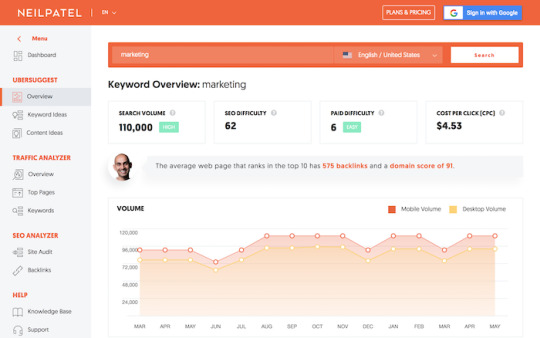
Once it loads, you’ll see a report like the one above. I want you to then click on “Keyword Ideas” in the left-hand navigation.
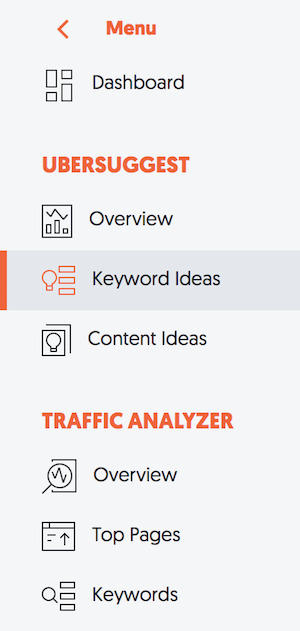
You’ll see a report that contains a list of keywords that you could potentially be targeting.
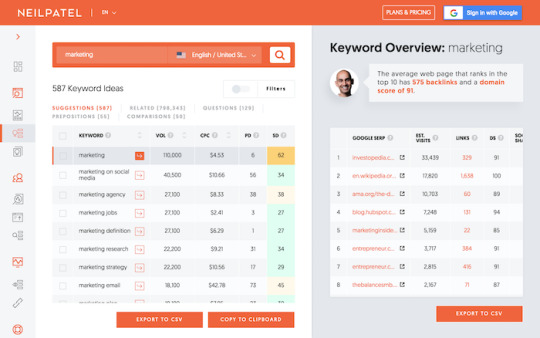
Make sure you click on the “Related” tab, as well as “Questions” and “Comparisons” … scroll through the list. You’ll see hundreds of keywords. Pick all of the ones that are relevant and ideally have a high cost per click (CPC). These are the keywords that’ll not only drive traffic but revenue as well.
Whenever I write a blog post, I go through this step. Every single time.
Lesson #4: AMP pages can drive more SEO traffic
AMP pages load faster on mobile devices than non-AMP pages.
If you aren’t familiar with the AMP framework, read this.
What most people won’t tell you about AMP pages is that:
In regions like the United States, Canada, and the United Kingdom, countries with decent Internet infrastructure, you won’t see much of an increase in traffic.
In regions with poor Internet infrastructure, like Brazil, you’ll see a 10 to 15% lift in mobile SEO traffic by having AMP pages.
AMP pages don’t convert visitors into customers as well as normal responsive web design. So, you’ll have to work on testing your AMP pages so you can boost your conversion rates.
Lesson #5: SEO will never convert as well as paid ads
When I started off with SEO, I would run projections on how much the traffic would make me.
But the numbers were always off, even if I was able to get the rankings.
Here’s the main reason: If you are bidding on terms like auto insurance through ads, you can drive people to a landing page that looks like this:
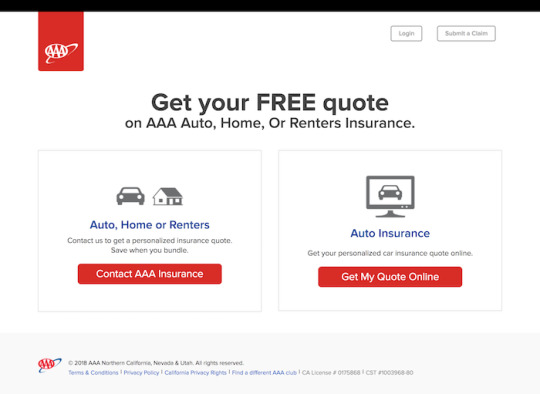
But if you want to rank organically, you’ll have to do it through content. So, your page that ranks well will look more like this and convert less…

It doesn’t mean SEO is bad. In reality, it’s much cheaper in the long run than paid ads and will produce a better ROI. But don’t just assume that if you get 100 visitors from paid ads and 3 purchases that you’ll have the same conversion rate with your SEO traffic.
Chances are it will be significantly lower by maybe 2 or 3x, but because SEO is cheaper, it will be much more profitable.
Lesson #6: Remarketing is one of the best ways to generate an ROI from SEO
If you get a ton of traffic from SEO, there is a simple strategy you can implement to boost your conversions.
Remarket everyone on Facebook, Google, and YouTube.
That way people come to your site, read your content, and build trust with you and your brand.
Then you remarket them throughout the web with ads that prompt your products or services and send them to a landing page that will drive sales.
I’ve been doing this for years, just look at my old remarketing ad…

For the regions I use remarketing in, it is responsible for 46% of my leads.
Lesson #7: Don’t forget to update your old content
I publish one new blog post a week. I’m working on increasing this as I get more time, but for now, it is one a week.
Can you guess how many blog posts I update on a daily basis? Technically it is 0 (me at least), but my team focuses on updating at least 3 old blog posts per day. That’s roughly 90 a month.
Once you have a few hundred pages, make sure you focus on updating your old content or else your traffic will quickly drop.
You can use this content decay tool to see which posts you should update first.
This will help you continually grow your SEO traffic instead of hitting plateaus or seeing your traffic take massive drops.
Lesson #8: Don’t forget to optimize your title tags
One of the easiest ways to grow your rankings is to optimize your title tags.
If you can write persuasive copy and get more clicks, you’ll quickly move up on Google.
In Brazil, we spend more time doing this than we do in the United States.
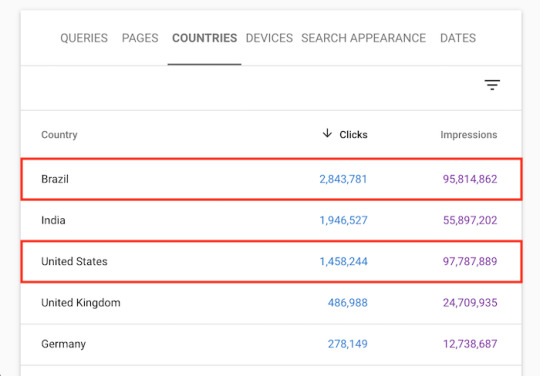
We get a similar amount of impressions in Brazil, but we have more people focusing on improving our title tags and testing. Hence, we get 95% more SEO traffic in Brazil.
If you want tips on boosting your clicks, check out this article.
Another simple hack is to use the “Content Ideas” report in Ubersuggest.
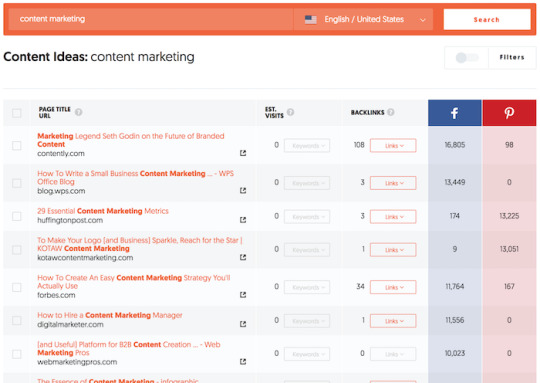
On the right side of that report, you can see social share counts from Facebook and Pinterest. And on the left side, you see titles of articles.
Typically, if people like a title they share it more. So, look for titles that have a lot of shares as it will give you ideas on what you can use on your website to get more clicks and boost your rankings.
Lesson #9: Don’t put dates in your URL
I used to put dates in my URLs like:
Neilpatel.com/2017/12/title-of-post/
This causes search engines to assume that your content is related to a specific date. And after that date gets old, search engines assume your content is irrelevant and outdated.
The moment I removed the date from my URLs, I grew my SEO traffic by 58% in 30 days.
youtube
If you have dates in your URL, make sure you 301 redirect your old URLs to your new ones once you make that change, or else your rankings will drop.
Lesson #10: Don’t be afraid to use popups
Don’t you hate popups? Well, who doesn’t?
But people use them because they work.
The majority of your pages that will rank are blog-related content. And blog posts tend to drive fewer direct conversions because people are on your site to read the content.
In order to maximize your conversions from SEO, you should consider using exit popups so you can convert more of those visitors into customers as they leave.
When you leave this site in most cases, you’ll see a popup that looks like:

And it drives you to this quiz, which allows me to convert SEO visitors into customers.
You can easily copy me by using Hello Bar. It works for all industries including B2B and ecommerce and even lead generation sites.
Lesson #11: Brand queries affect rankings
Everyone talks about how you need links to boost rankings.
But very few people talk about brand queries.
As Google’s ex-CEO and ex-head of web spam both emphasized how brands are important.

One of the big reasons for my growth in SEO traffic is the growth in my brand. I’ve seen a direct correlation in which the more people who find me from my name, the more SEO traffic I get.
Just look at my brand growth over time:
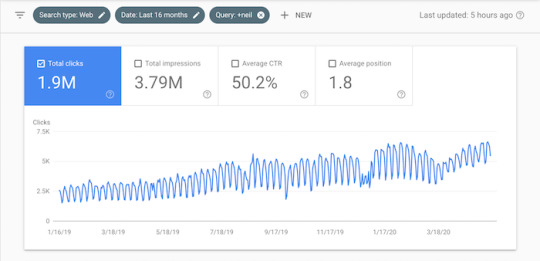
I’ve received over 1.9 million visitors over the last 16 months from people typing in variations of my name in Google.
Lesson #12: Don’t waste your money on paid links
I’ve been doing SEO since I was 16 years old. That’s a long time…
When I started off as a kid, I dabbled in paid links and I used to dominate Google for terms like online casino, online poker, web hosting, auto insurance, and even credit cards.
And I was making a killing off of affiliate income from these sites.
But it was all short lived.
Why?
Because I bought links. And eventually Google penalized all of those sites.
If I never purchased links, those sites would have taken longer to rank, but they would have been around today, and I would have generated more income overall.
Don’t buy links, it’s bad and shortsighted.
Lesson #13: Guest post to build a brand, not to build links
I already covered the importance of branding above.
A great way to build your brand and indirectly boost your SEO traffic is through guest posting.
But don’t use guest posting to build links.
Most sites that offer guest posts, nofollow them (which they should), and Google is smart enough to know what a guest post is, hence they ignore guest post links from sites like Forbes.
It’s pretty easy to spot a guest post for both a human and algorithm…
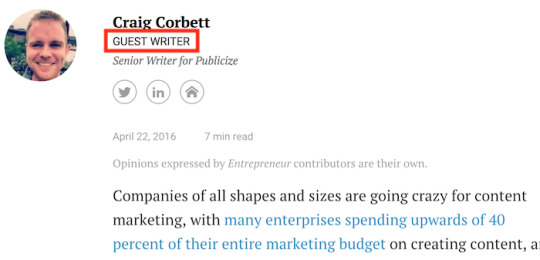
But if you are using it to build a brand, great. Focus on the content quality and not links.
Lesson #14: Don’t forget to interlink
Do you know what some of my highest ranked pages are?
The ones that are interlinked.
It takes anywhere from 6 months to a year for many of the interlinks to kick in, but it is still effective none-the-less.
Every time I wrote content, I used to make sure I link out to my older pieces of content when it made sense. But I made a big mistake… I wasn’t going into my older pieces of content and then adding links to my newer pieces of content.
That one change was game-changing for me. It took time to see the results but it worked exceptionally well.
It’s how I rank high for terms like “email marketing”.

Lesson #15: Google isn’t the only game in town
Although Google is the most popular search engine, it isn’t the only one you need to focus on.
Did you know that YouTube is the second most popular search engine?
Even Bing gets a lot of traffic.
If you want to rank high on Bing, follow this.
Or if you prefer video, watch this:
youtube
As for YouTube, this guide will teach you YouTube SEO. It works really well, just look at my YouTube SEO traffic:
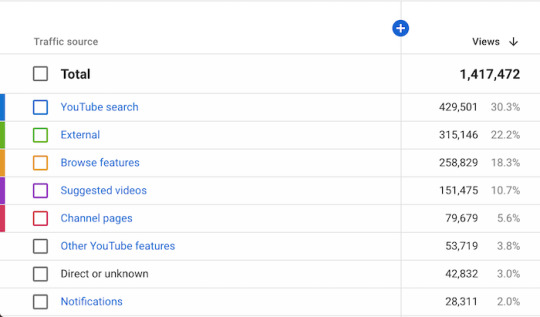
Over the last 28 days, I received 429,501 video views through YouTube SEO.
Lesson #16: Speed is everything
The faster your server and the more optimized your site, the more traffic you’ll get.
Years ago, my friend Otis added more servers to his site GoodReads.
Within a month, his SEO traffic went up over 20%.
Speed is part of Google’s algorithm, so optimize it for both web and mobile.
A quick way to see your site’s speed is to enter your URL here.

You’ll see a report that breaks down your mobile and desktop load times as well as what you can do to improve them.
Lesson #17: Quality over quantity
SEO used to be a game of quantity over quality.
That isn’t the case anymore. With over a billion blogs, Google has its fair share of sites to choose from.
Just look at About.com. Eventually they renamed it Dotdash and changed their strategy.

They took all of their About.com content and moved it over to 6 vertical based sites and deleted 900,000 pages of junk content.
This grew their traffic and revenue by a whopping 140%.
Focus on writing high-quality content. It’s why I blog less and try to make my content amazing.
Lesson #18: Tools are better than content marketing
I used to focus all of my energy on content marketing because it drove a lot of links and SEO traffic.
But over time, I realized that creating free tools builds more natural links than anything else I have ever tested.
Just look at Ubersuggest. I spent years creating it and look at how many links it has generated…
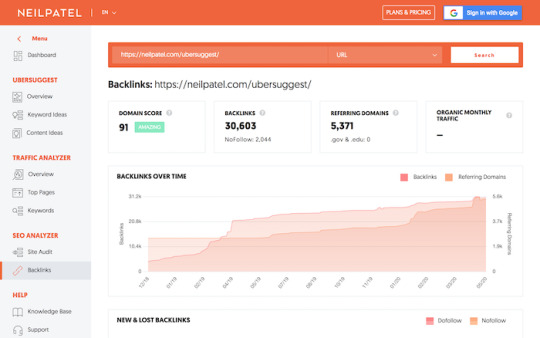
30,603 backlinks! That’s a lot of links.
If you don’t have the resources to build a custom tool like me, you can always start with buying a white label tool from Code Canyon for $10 or $20. They literally have tools for almost all industries.
Lesson #19: Don’t rely only on SEO
When I first got started in SEO, all I could think about was SEO.
To me, it was the best marketing channel out there because it allowed me to compete with large companies.
Even to this day, I still love SEO more than any other channel.
But it doesn’t stop me from leveraging other marketing channels.
See, years ago you could build a business off of one marketing channel.
Yelp was built through SEO. Dropbox through social media referrals. Facebook through email invites…
Those days don’t exist anymore. You can’t just build your traffic from one channel.
Although you should do SEO, you should also try paid ads, social media marketing, email marketing, push notifications, and anything else that comes out.
Diversify your traffic sources and don’t just rely solely on SEO.
Lesson #20: People love linking to data
Spending money and time to gather your own unique data is an easy way to build links.
Check out my posts on content marketing trends and social media trends.
I’ve added tons of unique data, stats, and charts to each of those posts.
The end result? Extra backlinks. 🙂
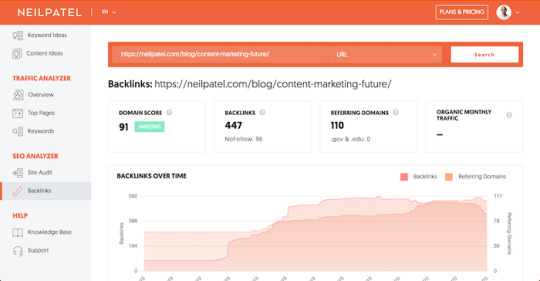
The content marketing trends post received 447 backlinks.
If you don’t have the time to gather custom data you can always find someone on Upwork to help you out.
Lesson #21: Don’t forget about Infographics
One of my favorite SEO strategies that still works well today is infographics.
I have tons of them on the NeilPatel.com blog.
I didn’t start off with infographics here… I used to do them on my old blog Quick Sprout and KISSmetrics.
Here’s an interesting stat for you when I used to crank out infographics on KISSmetrics.
Within a two-year period, from 2010 to 2012, 47 infographics generated 2,512,596 visitors and 41,142 backlinks from 3,741 unique domains. They also generated 41,359 tweets and 20,859 likes.
If you don’t have money to hire a designer, you can use Infogram or Canva to create one on your own.
Lesson #22: Google doesn’t penalize for duplicate content
You don’t want to post tons of duplicate content on your site as it’s not the best user experience, but keep in mind that Google doesn’t penalize you for duplication.
They may not just rank the duplicate content as well.
So, if you spend all of this time producing amazing, unique content, why not publish it FIRST on your own website.
Then after a few hours or days if you want to be safe, take that exact content and publish it on Facebook, LinkedIn, and anywhere else that will accept your content.
Literally, take all of the words and paste them onto those social channels.
It will get you extra awareness and branding. Plus, the content should already be indexed on your site, so Google knows it came from your first… and I doubt you care if the duplicated version on LinkedIn ranks. That’s still great branding.
In other words, don’t be afraid to repurpose your content even if it causes duplication.
Just look at this post, for example. I’m also repurposing it into a 4-part podcast series.
Lesson #23: Don’t recreate the wheel
I used to spend hours a week doing keyword research trying to figure out what new terms to rank for.
Eventually, I figured out an easier and better way to find new content topics and keywords to go after.
Go to Ubersuggest, type in your competitor’s domain name and hit search.
In the left-hand navigation click on Top Pages.
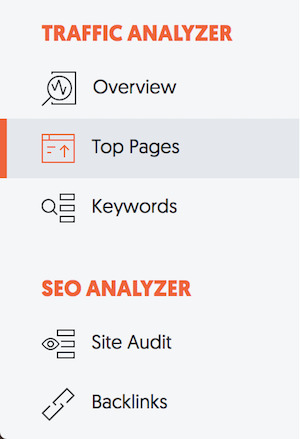
You’ll see a report that shows you all of the popular pages on your competition’s website. This will give you ideas for the type of pages you should create on your website.

Then I want you to click “View All” under Est. Visits (estimated visits). This will show you all of the keywords that drive traffic to that page.

You now have a list of topics and keywords for each topic to go after.
Lesson #24: Don’t pick a generic domain name
Remember how in Lesson 11 I talked about brand queries and how they helped rankings?
After I learned that, I decided to go buy exact match domain names where the domain name was the keyword.
That way I would get lots of brand queries without trying.
Well, there’s an issue… even if you rank high, what you’ll find is you will have a low click-through rate in most cases.
If you have a low click-through rate, it tells Google your brand isn’t strong and people don’t prefer it, which can hurt your ranking.
So instead of focusing on exact match domains, unless you have millions to spend on branding like Hotels.com, focus on building a memorable brand.
youtube
Pick something that is unique, easy to spell, and easy to remember.
Lesson #25: Learn from blackhat SEOs, but don’t go over to the dark side
Blackhat SEOs come up with some interesting data and experiments.
Many of them don’t work for long, but they are interesting none-the-less.
Although I don’t recommend practicing blackhat SEO, I do recommend following them.
The easiest way you can learn from them is by reading Blackhat World.
People there share some interesting insights, especially every time there is a major Google algorithm update.
Again, I don’t recommend practicing blackhat SEO, but following them may help you uncover “white hat” techniques that can increase your rankings. Not everything they do is bad… many of them use legitimate tactics as well.
Lesson #26: Short URLs rank better than long ones
My URLs used to be the title of my blog post.
For example, with this post I would have used this URL in the past…
Neilpatel.com/blog/30-lessons-after-30-million-seo-visitors/
Eventually I switched to short URLs.
Google just prefers them. And I’ve seen it firsthand. That’s why I use short ones now.

URLs at position #1 are on average 9.2 characters shorter than URLs that rank in position #10. So, keep them short.
Lesson #27: The power’s in the list
If you want your content to rank high on Google, you need more people to see it.
Whether it is from social shares, or from push notifications or email blasts… the more people that see your content, the more engagement it will get, and the more people that will link to it.
I used to do a ton of manual outreach every time I published a new blog post and I would email people asking them to link to me.
And it works, it’s just time consuming and a pain.
These days, I have a better strategy… send out an email blast every time I publish a new post.

I can now get anywhere from 20,000 to 50,000 clicks per email I send out.
Now of course you won’t get that from day one as it took me years to build up my email list.
But you can start today by collecting emails. You can easily do that through Hello Bar.
And as your list grows, so will the clicks to your blog and the number of links you get, which in turn will increase your rankings.
Lesson #28: Don’t let your foot off the peddle
This was one of the hardest lessons I learned.
It’s exhausting to continually blog and do your own SEO. Sometimes you just want a break.
With my old blog, Quick Sprout, I used to publish 12 blog posts a month and I did that consistently for 3 years.
One day I decided that I wanted to stop for a month. So, I took a 30-day break.
Guess what happened to my traffic?
It tanked by 32%.
So, then I started blogging again. And guessed what happened to my traffic after I started blogging?
It didn’t come right back.
It took me 3 months to get back to where I was.
When things are working for you, don’t slow down. Keep pushing harder, even if you are exhausted. Because the moment you stop, you’ll drop, and it is a lot of work to get back to where you were.
Lesson #29: The best SEO advice comes from conferences
The best SEO advice I have ever learned over the years has come from conferences.
And no, I don’t mean by sitting in on the sessions, although you can learn from those too.
The best SEO secrets and advice I learned came from networking. When you go to these conferences, hundreds if not thousands of other SEOs are there. And when you go to the bar after hours and mingle with people, you’ll quickly pick stuff up.
You’ll be shocked at what people tell you. It’s how I learned a lot of the good tactics that I still use today.
Lesson #30: Never stop learning
This one may sound obvious but when things are going well, people get complacent.
Google makes on average 3,234 updates per year and that count has been increasing over time.
Just think about that for a bit… that’s roughly 9 algorithm updates per day.
Because they are changing so quickly, you won’t survive if you don’t stay up to date.
Yes, the ideal strategy is to do what’s best for your users or visitors as in the long run, Google wants to promote those sites, but it doesn’t mean that you can ignore the changes happening in the industry.
Read all of the SEO blogs out there, attend conferences as I mentioned above… experiment on test sites… push yourself to be better.
That drive of always improving and always wanting to learn more has helped me tremendously. It’s one of the reasons for my growth in rankings over the years.
Conclusion
There are a lot of lessons that you will learn as your rankings grow and as you spend more time on SEO.
But hopefully, you don’t have to waste time and go through the same mistakes I made. You don’t want to learn these lessons the hard way.
That’s why I decided to share them. I want to save you the time and help you achieve your traffic goals faster.
Which SEO lessons have you learned?
The post 30 Lessons After 30 Million SEO Visitors appeared first on Neil Patel.
30 Lessons After 30 Million SEO Visitors Publicado primeiro em https://neilpatel.com
0 notes
Text
30 Lessons After 30 Million SEO Visitors

As you can see from the screenshot above, I’ve driven 30 million visitors to my website from SEO.
Technically it’s more, but who’s counting.
What’s funny, though, is I barely look at my traffic, even as Google continually rolls out algorithm updates.
I know that sounds contradictory because if you are an SEO, why wouldn’t you obsess about traffic, right?
Well, it’s because I’ve learned some hard lessons over the year… mainly because I’ve made a lot of mistakes.
So today, I wanted to share them with you so that you can learn from my mistakes… so here goes:
Lesson #1: Don’t obsess over rankings, obsess over conversions
I used to check my rankings every single day. Literally.
On top of that, I would log into Google Analytics 4 to 5 times a day and continually check my traffic.
That’s all I cared about back in the day… boosting my organic traffic.
But here is the thing: As my rankings and traffic went up over the years, my revenue didn’t go up proportionally.
For example, during one quarter in 2017, my SEO traffic went up 39.52%, but my revenue from SEO went up only 4.29%.
I quickly learned that traffic isn’t everything. If you can’t convert the traffic into revenue it doesn’t matter.
That taught me that you need to focus on the right keywords that drive conversions and continually optimize your site for conversions.
An easy first step for you to take is to install Crazy Egg and run a heatmap to see where people click so you adjust your design and copy to get more sales.

Lesson #2: The easiest way to grow your SEO traffic is international expansion
You already know that I get a lot of SEO traffic, but do you know what country drives most of my traffic?
If you guessed United States, you are wrong.
Brazil is my most popular region, followed by India.

International SEO is the easiest way to expand and grow your traffic. Here are a few posts that you should read before you expand your SEO globally:
How to create a global SEO strategy
Fundamentals of international SEO
How to correctly setup your site for international SEO
How to profitably expand your SEO globally
Lesson #3: Keywords are very, very, very, very important
When I used to write my content, I didn’t obsess about the keywords when I should have.
My team actually proved me wrong on this.
I used to focus on writing content for humans and didn’t worry about search engines. My team, on the other hand, obsesses about keywords.
Just look at the growth of our traffic in Brazil because of our obsession with the right keywords.
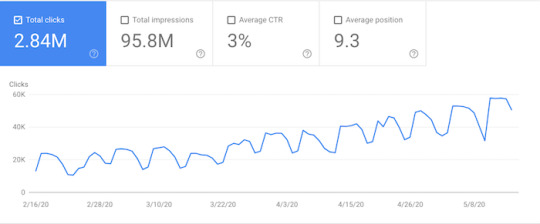
One simple thing I do before writing that has really helped is I head over to Ubersuggest and type in a few of the keywords that I want to go after.
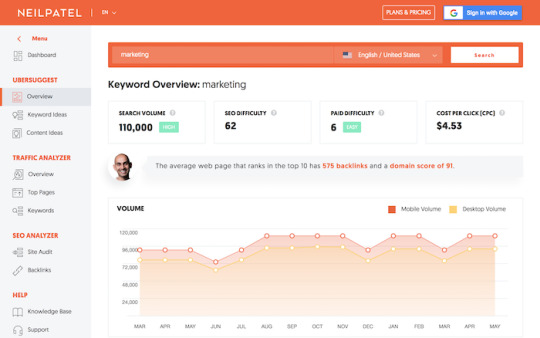
Once it loads, you’ll see a report like the one above. I want you to then click on “Keyword Ideas” in the left-hand navigation.
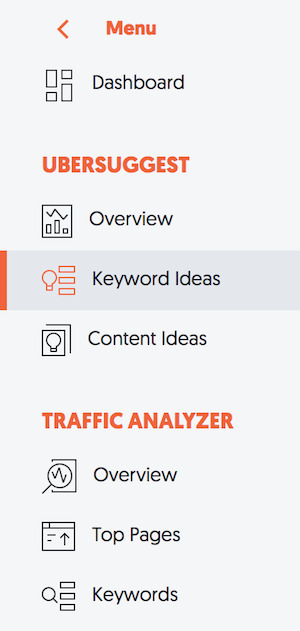
You’ll see a report that contains a list of keywords that you could potentially be targeting.
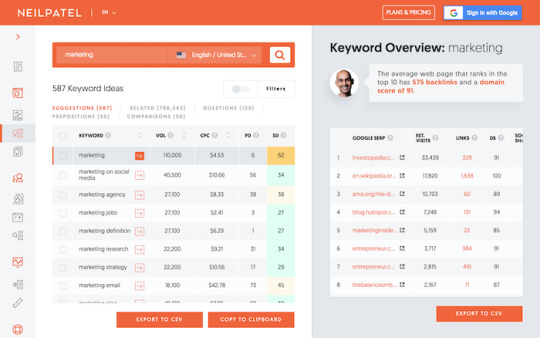
Make sure you click on the “Related” tab, as well as “Questions” and “Comparisons” … scroll through the list. You’ll see hundreds of keywords. Pick all of the ones that are relevant and ideally have a high cost per click (CPC). These are the keywords that’ll not only drive traffic but revenue as well.
Whenever I write a blog post, I go through this step. Every single time.
Lesson #4: AMP pages can drive more SEO traffic
AMP pages load faster on mobile devices than non-AMP pages.
If you aren’t familiar with the AMP framework, read this.
What most people won’t tell you about AMP pages is that:
In regions like the United States, Canada, and the United Kingdom, countries with decent Internet infrastructure, you won’t see much of an increase in traffic.
In regions with poor Internet infrastructure, like Brazil, you’ll see a 10 to 15% lift in mobile SEO traffic by having AMP pages.
AMP pages don’t convert visitors into customers as well as normal responsive web design. So, you’ll have to work on testing your AMP pages so you can boost your conversion rates.
Lesson #5: SEO will never convert as well as paid ads
When I started off with SEO, I would run projections on how much the traffic would make me.
But the numbers were always off, even if I was able to get the rankings.
Here’s the main reason: If you are bidding on terms like auto insurance through ads, you can drive people to a landing page that looks like this:

But if you want to rank organically, you’ll have to do it through content. So, your page that ranks well will look more like this and convert less…
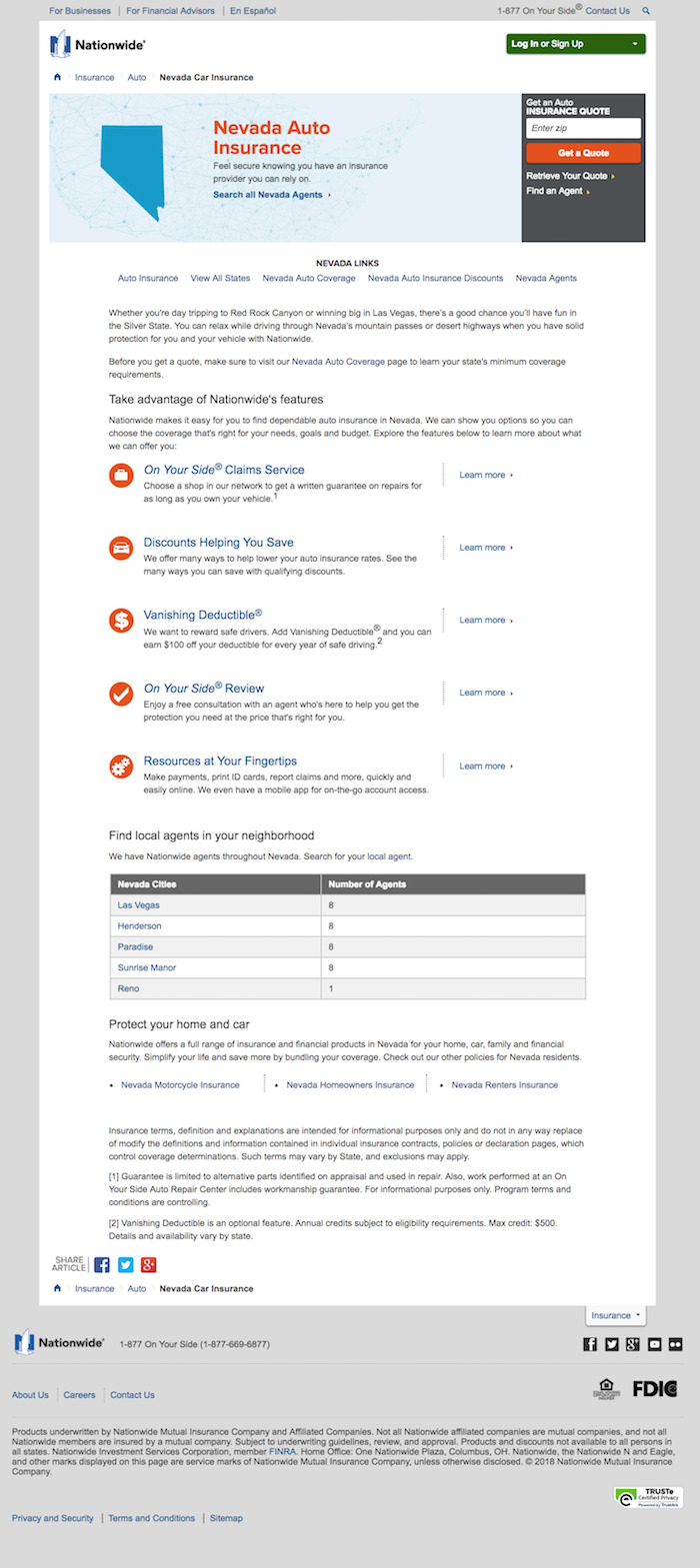
It doesn’t mean SEO is bad. In reality, it’s much cheaper in the long run than paid ads and will produce a better ROI. But don’t just assume that if you get 100 visitors from paid ads and 3 purchases that you’ll have the same conversion rate with your SEO traffic.
Chances are it will be significantly lower by maybe 2 or 3x, but because SEO is cheaper, it will be much more profitable.
Lesson #6: Remarketing is one of the best ways to generate an ROI from SEO
If you get a ton of traffic from SEO, there is a simple strategy you can implement to boost your conversions.
Remarket everyone on Facebook, Google, and YouTube.
That way people come to your site, read your content, and build trust with you and your brand.
Then you remarket them throughout the web with ads that prompt your products or services and send them to a landing page that will drive sales.
I’ve been doing this for years, just look at my old remarketing ad…

For the regions I use remarketing in, it is responsible for 46% of my leads.
Lesson #7: Don’t forget to update your old content
I publish one new blog post a week. I’m working on increasing this as I get more time, but for now, it is one a week.
Can you guess how many blog posts I update on a daily basis? Technically it is 0 (me at least), but my team focuses on updating at least 3 old blog posts per day. That’s roughly 90 a month.
Once you have a few hundred pages, make sure you focus on updating your old content or else your traffic will quickly drop.
You can use this content decay tool to see which posts you should update first.
This will help you continually grow your SEO traffic instead of hitting plateaus or seeing your traffic take massive drops.
Lesson #8: Don’t forget to optimize your title tags
One of the easiest ways to grow your rankings is to optimize your title tags.
If you can write persuasive copy and get more clicks, you’ll quickly move up on Google.
In Brazil, we spend more time doing this than we do in the United States.

We get a similar amount of impressions in Brazil, but we have more people focusing on improving our title tags and testing. Hence, we get 95% more SEO traffic in Brazil.
If you want tips on boosting your clicks, check out this article.
Another simple hack is to use the “Content Ideas” report in Ubersuggest.

On the right side of that report, you can see social share counts from Facebook and Pinterest. And on the left side, you see titles of articles.
Typically, if people like a title they share it more. So, look for titles that have a lot of shares as it will give you ideas on what you can use on your website to get more clicks and boost your rankings.
Lesson #9: Don’t put dates in your URL
I used to put dates in my URLs like:
Neilpatel.com/2017/12/title-of-post/
This causes search engines to assume that your content is related to a specific date. And after that date gets old, search engines assume your content is irrelevant and outdated.
The moment I removed the date from my URLs, I grew my SEO traffic by 58% in 30 days.
If you have dates in your URL, make sure you 301 redirect your old URLs to your new ones once you make that change, or else your rankings will drop.
Lesson #10: Don’t be afraid to use popups
Don’t you hate popups? Well, who doesn’t?
But people use them because they work.
The majority of your pages that will rank are blog-related content. And blog posts tend to drive fewer direct conversions because people are on your site to read the content.
In order to maximize your conversions from SEO, you should consider using exit popups so you can convert more of those visitors into customers as they leave.
When you leave this site in most cases, you’ll see a popup that looks like:

And it drives you to this quiz, which allows me to convert SEO visitors into customers.
You can easily copy me by using Hello Bar. It works for all industries including B2B and ecommerce and even lead generation sites.
Lesson #11: Brand queries affect rankings
Everyone talks about how you need links to boost rankings.
But very few people talk about brand queries.
As Google’s ex-CEO and ex-head of web spam both emphasized how brands are important.

One of the big reasons for my growth in SEO traffic is the growth in my brand. I’ve seen a direct correlation in which the more people who find me from my name, the more SEO traffic I get.
Just look at my brand growth over time:
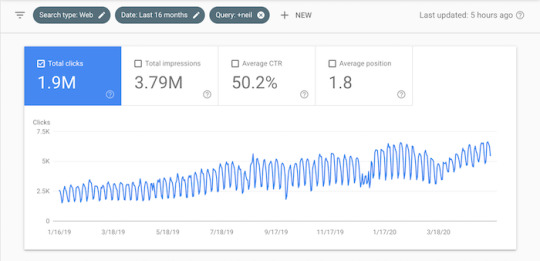
I’ve received over 1.9 million visitors over the last 16 months from people typing in variations of my name in Google.
Lesson #12: Don’t waste your money on paid links
I’ve been doing SEO since I was 16 years old. That’s a long time…
When I started off as a kid, I dabbled in paid links and I used to dominate Google for terms like online casino, online poker, web hosting, auto insurance, and even credit cards.
And I was making a killing off of affiliate income from these sites.
But it was all short lived.
Why?
Because I bought links. And eventually Google penalized all of those sites.
If I never purchased links, those sites would have taken longer to rank, but they would have been around today, and I would have generated more income overall.
Don’t buy links, it’s bad and shortsighted.
Lesson #13: Guest post to build a brand, not to build links
I already covered the importance of branding above.
A great way to build your brand and indirectly boost your SEO traffic is through guest posting.
But don’t use guest posting to build links.
Most sites that offer guest posts, nofollow them (which they should), and Google is smart enough to know what a guest post is, hence they ignore guest post links from sites like Forbes.
It’s pretty easy to spot a guest post for both a human and algorithm…
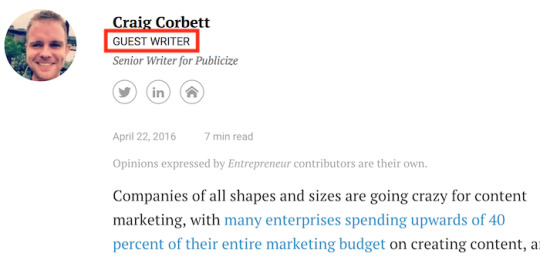
But if you are using it to build a brand, great. Focus on the content quality and not links.
Lesson #14: Don’t forget to interlink
Do you know what some of my highest ranked pages are?
The ones that are interlinked.
It takes anywhere from 6 months to a year for many of the interlinks to kick in, but it is still effective none-the-less.
Every time I wrote content, I used to make sure I link out to my older pieces of content when it made sense. But I made a big mistake… I wasn’t going into my older pieces of content and then adding links to my newer pieces of content.
That one change was game-changing for me. It took time to see the results but it worked exceptionally well.
It’s how I rank high for terms like “email marketing”.
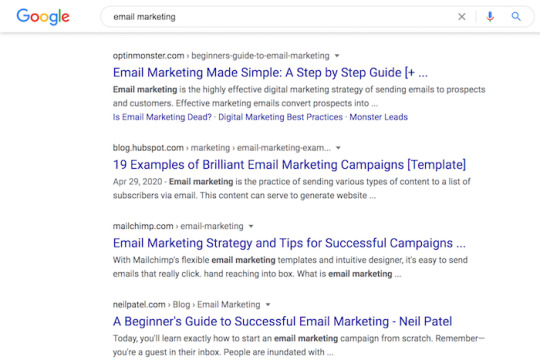
Lesson #15: Google isn’t the only game in town
Although Google is the most popular search engine, it isn’t the only one you need to focus on.
Did you know that YouTube is the second most popular search engine?
Even Bing gets a lot of traffic.
If you want to rank high on Bing, follow this.
Or if you prefer video, watch this:
As for YouTube, this guide will teach you YouTube SEO. It works really well, just look at my YouTube SEO traffic:
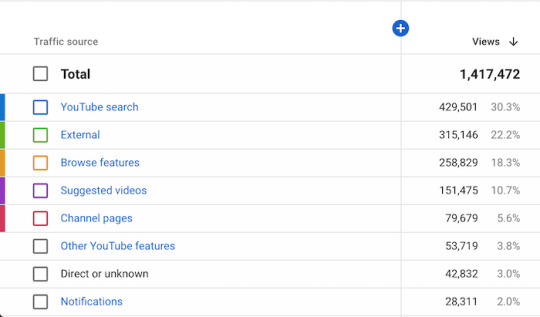
Over the last 28 days, I received 429,501 video views through YouTube SEO.
Lesson #16: Speed is everything
The faster your server and the more optimized your site, the more traffic you’ll get.
Years ago, my friend Otis added more servers to his site GoodReads.
Within a month, his SEO traffic went up over 20%.
Speed is part of Google’s algorithm, so optimize it for both web and mobile.
A quick way to see your site’s speed is to enter your URL here.
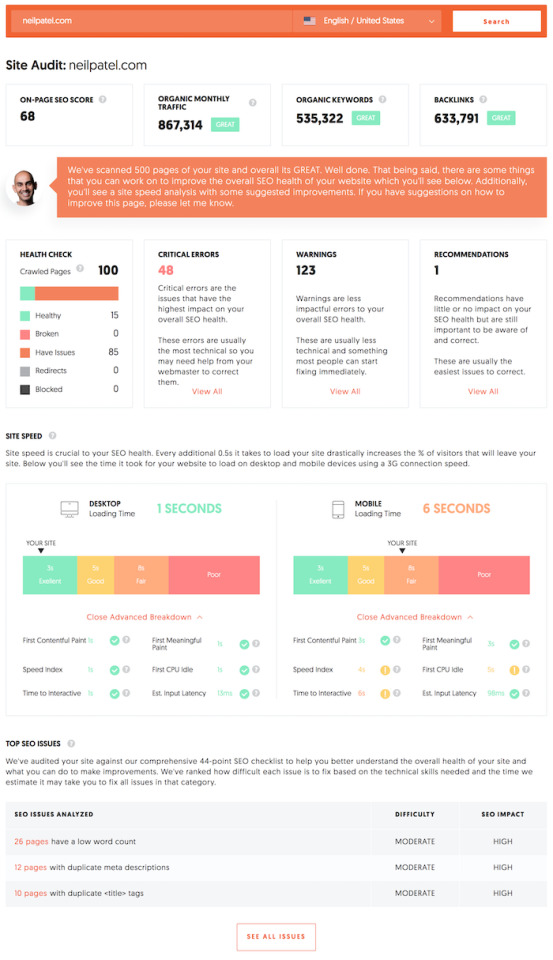
You’ll see a report that breaks down your mobile and desktop load times as well as what you can do to improve them.
Lesson #17: Quality over quantity
SEO used to be a game of quantity over quality.
That isn’t the case anymore. With over a billion blogs, Google has its fair share of sites to choose from.
Just look at About.com. Eventually they renamed it Dotdash and changed their strategy.
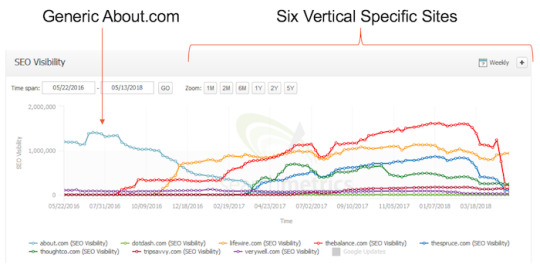
They took all of their About.com content and moved it over to 6 vertical based sites and deleted 900,000 pages of junk content.
This grew their traffic and revenue by a whopping 140%.
Focus on writing high-quality content. It’s why I blog less and try to make my content amazing.
Lesson #18: Tools are better than content marketing
I used to focus all of my energy on content marketing because it drove a lot of links and SEO traffic.
But over time, I realized that creating free tools builds more natural links than anything else I have ever tested.
Just look at Ubersuggest. I spent years creating it and look at how many links it has generated…
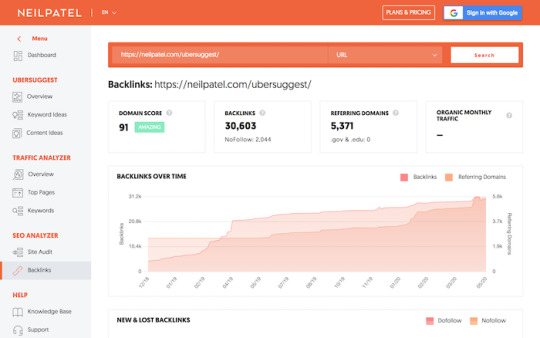
30,603 backlinks! That’s a lot of links.
If you don’t have the resources to build a custom tool like me, you can always start with buying a white label tool from Code Canyon for $10 or $20. They literally have tools for almost all industries.
Lesson #19: Don’t rely only on SEO
When I first got started in SEO, all I could think about was SEO.
To me, it was the best marketing channel out there because it allowed me to compete with large companies.
Even to this day, I still love SEO more than any other channel.
But it doesn’t stop me from leveraging other marketing channels.
See, years ago you could build a business off of one marketing channel.
Yelp was built through SEO. Dropbox through social media referrals. Facebook through email invites…
Those days don’t exist anymore. You can’t just build your traffic from one channel.
Although you should do SEO, you should also try paid ads, social media marketing, email marketing, push notifications, and anything else that comes out.
Diversify your traffic sources and don’t just rely solely on SEO.
Lesson #20: People love linking to data
Spending money and time to gather your own unique data is an easy way to build links.
Check out my posts on content marketing trends and social media trends.
I’ve added tons of unique data, stats, and charts to each of those posts.
The end result? Extra backlinks. ?

The content marketing trends post received 447 backlinks.
If you don’t have the time to gather custom data you can always find someone on Upwork to help you out.
Lesson #21: Don’t forget about Infographics
One of my favorite SEO strategies that still works well today is infographics.
I have tons of them on the NeilPatel.com blog.
I didn’t start off with infographics here… I used to do them on my old blog Quick Sprout and KISSmetrics.
Here’s an interesting stat for you when I used to crank out infographics on KISSmetrics.
Within a two-year period, from 2010 to 2012, 47 infographics generated 2,512,596 visitors and 41,142 backlinks from 3,741 unique domains. They also generated 41,359 tweets and 20,859 likes.
If you don’t have money to hire a designer, you can use Infogram or Canva to create one on your own.
Lesson #22: Google doesn’t penalize for duplicate content
You don’t want to post tons of duplicate content on your site as it’s not the best user experience, but keep in mind that Google doesn’t penalize you for duplication.
They may not just rank the duplicate content as well.
So, if you spend all of this time producing amazing, unique content, why not publish it FIRST on your own website.
Then after a few hours or days if you want to be safe, take that exact content and publish it on Facebook, LinkedIn, and anywhere else that will accept your content.
Literally, take all of the words and paste them onto those social channels.
It will get you extra awareness and branding. Plus, the content should already be indexed on your site, so Google knows it came from your first… and I doubt you care if the duplicated version on LinkedIn ranks. That’s still great branding.
In other words, don’t be afraid to repurpose your content even if it causes duplication.
Just look at this post, for example. I’m also repurposing it into a 4-part podcast series.
Lesson #23: Don’t recreate the wheel
I used to spend hours a week doing keyword research trying to figure out what new terms to rank for.
Eventually, I figured out an easier and better way to find new content topics and keywords to go after.
Go to Ubersuggest, type in your competitor’s domain name and hit search.
In the left-hand navigation click on Top Pages.
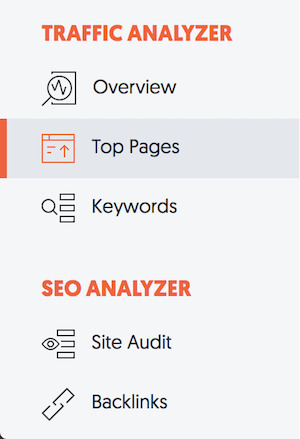
You’ll see a report that shows you all of the popular pages on your competition’s website. This will give you ideas for the type of pages you should create on your website.

Then I want you to click “View All” under Est. Visits (estimated visits). This will show you all of the keywords that drive traffic to that page.
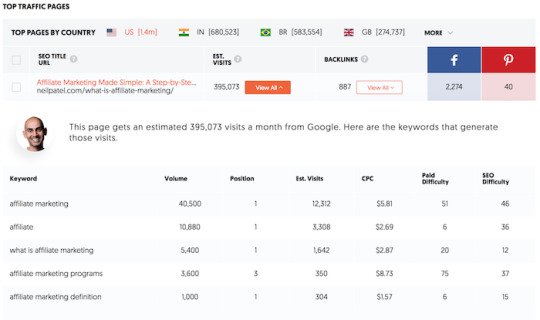
You now have a list of topics and keywords for each topic to go after.
Lesson #24: Don’t pick a generic domain name
Remember how in Lesson 11 I talked about brand queries and how they helped rankings?
After I learned that, I decided to go buy exact match domain names where the domain name was the keyword.
That way I would get lots of brand queries without trying.
Well, there’s an issue… even if you rank high, what you’ll find is you will have a low click-through rate in most cases.
If you have a low click-through rate, it tells Google your brand isn’t strong and people don’t prefer it, which can hurt your ranking.
So instead of focusing on exact match domains, unless you have millions to spend on branding like Hotels.com, focus on building a memorable brand.
Pick something that is unique, easy to spell, and easy to remember.
Lesson #25: Learn from blackhat SEOs, but don’t go over to the dark side
Blackhat SEOs come up with some interesting data and experiments.
Many of them don’t work for long, but they are interesting none-the-less.
Although I don’t recommend practicing blackhat SEO, I do recommend following them.
The easiest way you can learn from them is by reading Blackhat World.
People there share some interesting insights, especially every time there is a major Google algorithm update.
Again, I don’t recommend practicing blackhat SEO, but following them may help you uncover “white hat” techniques that can increase your rankings. Not everything they do is bad… many of them use legitimate tactics as well.
Lesson #26: Short URLs rank better than long ones
My URLs used to be the title of my blog post.
For example, with this post I would have used this URL in the past…
Neilpatel.com/blog/30-lessons-after-30-million-seo-visitors/
Eventually I switched to short URLs.
Google just prefers them. And I’ve seen it firsthand. That’s why I use short ones now.
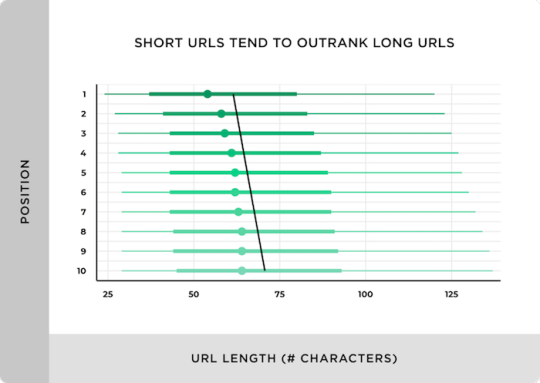
URLs at position #1 are on average 9.2 characters shorter than URLs that rank in position #10. So, keep them short.
Lesson #27: The power’s in the list
If you want your content to rank high on Google, you need more people to see it.
Whether it is from social shares, or from push notifications or email blasts… the more people that see your content, the more engagement it will get, and the more people that will link to it.
I used to do a ton of manual outreach every time I published a new blog post and I would email people asking them to link to me.
And it works, it’s just time consuming and a pain.
These days, I have a better strategy… send out an email blast every time I publish a new post.

I can now get anywhere from 20,000 to 50,000 clicks per email I send out.
Now of course you won’t get that from day one as it took me years to build up my email list.
But you can start today by collecting emails. You can easily do that through Hello Bar.
And as your list grows, so will the clicks to your blog and the number of links you get, which in turn will increase your rankings.
Lesson #28: Don’t let your foot off the peddle
This was one of the hardest lessons I learned.
It’s exhausting to continually blog and do your own SEO. Sometimes you just want a break.
With my old blog, Quick Sprout, I used to publish 12 blog posts a month and I did that consistently for 3 years.
One day I decided that I wanted to stop for a month. So, I took a 30-day break.
Guess what happened to my traffic?
It tanked by 32%.
So, then I started blogging again. And guessed what happened to my traffic after I started blogging?
It didn’t come right back.
It took me 3 months to get back to where I was.
When things are working for you, don’t slow down. Keep pushing harder, even if you are exhausted. Because the moment you stop, you’ll drop, and it is a lot of work to get back to where you were.
Lesson #29: The best SEO advice comes from conferences
The best SEO advice I have ever learned over the years has come from conferences.
And no, I don’t mean by sitting in on the sessions, although you can learn from those too.
The best SEO secrets and advice I learned came from networking. When you go to these conferences, hundreds if not thousands of other SEOs are there. And when you go to the bar after hours and mingle with people, you’ll quickly pick stuff up.
You’ll be shocked at what people tell you. It’s how I learned a lot of the good tactics that I still use today.
Lesson #30: Never stop learning
This one may sound obvious but when things are going well, people get complacent.
Google makes on average 3,234 updates per year and that count has been increasing over time.
Just think about that for a bit… that’s roughly 9 algorithm updates per day.
Because they are changing so quickly, you won’t survive if you don’t stay up to date.
Yes, the ideal strategy is to do what’s best for your users or visitors as in the long run, Google wants to promote those sites, but it doesn’t mean that you can ignore the changes happening in the industry.
Read all of the SEO blogs out there, attend conferences as I mentioned above… experiment on test sites… push yourself to be better.
That drive of always improving and always wanting to learn more has helped me tremendously. It’s one of the reasons for my growth in rankings over the years.
Conclusion
There are a lot of lessons that you will learn as your rankings grow and as you spend more time on SEO.
But hopefully, you don’t have to waste time and go through the same mistakes I made. You don’t want to learn these lessons the hard way.
That’s why I decided to share them. I want to save you the time and help you achieve your traffic goals faster.
Which SEO lessons have you learned?
The post 30 Lessons After 30 Million SEO Visitors appeared first on Neil Patel.
Original content source: https://neilpatel.com/blog/seo-visitors/ via https://neilpatel.com
See the original post, 30 Lessons After 30 Million SEO Visitors that is shared from https://imtrainingparadise.weebly.com/home/30-lessons-after-30-million-seo-visitors via https://imtrainingparadise.weebly.com/home
0 notes
Text
30 Lessons After 30 Million SEO Visitors
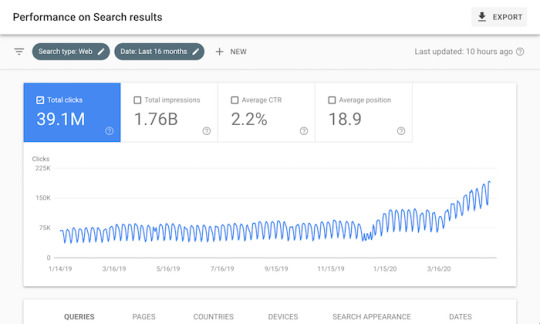
As you can see from the screenshot above, I’ve driven 30 million visitors to my website from SEO.
Technically it’s more, but who’s counting.
What’s funny, though, is I barely look at my traffic, even as Google continually rolls out algorithm updates.
I know that sounds contradictory because if you are an SEO, why wouldn’t you obsess about traffic, right?
Well, it’s because I’ve learned some hard lessons over the year… mainly because I’ve made a lot of mistakes.
So today, I wanted to share them with you so that you can learn from my mistakes… so here goes:
Lesson #1: Don’t obsess over rankings, obsess over conversions
I used to check my rankings every single day. Literally.
On top of that, I would log into Google Analytics 4 to 5 times a day and continually check my traffic.
That’s all I cared about back in the day… boosting my organic traffic.
But here is the thing: As my rankings and traffic went up over the years, my revenue didn’t go up proportionally.
For example, during one quarter in 2017, my SEO traffic went up 39.52%, but my revenue from SEO went up only 4.29%.
I quickly learned that traffic isn’t everything. If you can’t convert the traffic into revenue it doesn’t matter.
That taught me that you need to focus on the right keywords that drive conversions and continually optimize your site for conversions.
An easy first step for you to take is to install Crazy Egg and run a heatmap to see where people click so you adjust your design and copy to get more sales.

Lesson #2: The easiest way to grow your SEO traffic is international expansion
You already know that I get a lot of SEO traffic, but do you know what country drives most of my traffic?
If you guessed United States, you are wrong.
Brazil is my most popular region, followed by India.

International SEO is the easiest way to expand and grow your traffic. Here are a few posts that you should read before you expand your SEO globally:
How to create a global SEO strategy
Fundamentals of international SEO
How to correctly setup your site for international SEO
How to profitably expand your SEO globally
Lesson #3: Keywords are very, very, very, very important
When I used to write my content, I didn’t obsess about the keywords when I should have.
My team actually proved me wrong on this.
I used to focus on writing content for humans and didn’t worry about search engines. My team, on the other hand, obsesses about keywords.
Just look at the growth of our traffic in Brazil because of our obsession with the right keywords.
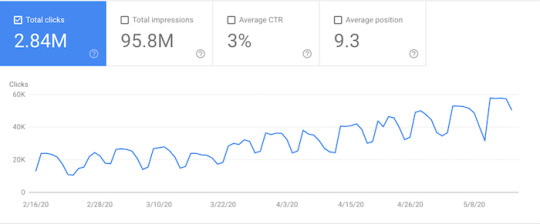
One simple thing I do before writing that has really helped is I head over to Ubersuggest and type in a few of the keywords that I want to go after.
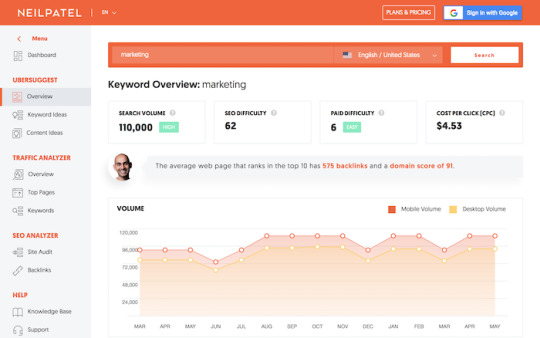
Once it loads, you’ll see a report like the one above. I want you to then click on “Keyword Ideas” in the left-hand navigation.

You’ll see a report that contains a list of keywords that you could potentially be targeting.
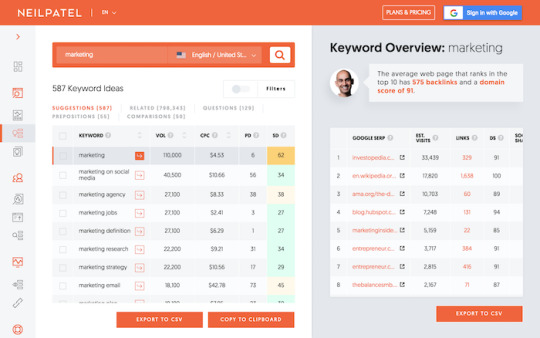
Make sure you click on the “Related” tab, as well as “Questions” and “Comparisons” … scroll through the list. You’ll see hundreds of keywords. Pick all of the ones that are relevant and ideally have a high cost per click (CPC). These are the keywords that’ll not only drive traffic but revenue as well.
Whenever I write a blog post, I go through this step. Every single time.
Lesson #4: AMP pages can drive more SEO traffic
AMP pages load faster on mobile devices than non-AMP pages.
If you aren’t familiar with the AMP framework, read this.
What most people won’t tell you about AMP pages is that:
In regions like the United States, Canada, and the United Kingdom, countries with decent Internet infrastructure, you won’t see much of an increase in traffic.
In regions with poor Internet infrastructure, like Brazil, you’ll see a 10 to 15% lift in mobile SEO traffic by having AMP pages.
AMP pages don’t convert visitors into customers as well as normal responsive web design. So, you’ll have to work on testing your AMP pages so you can boost your conversion rates.
Lesson #5: SEO will never convert as well as paid ads
When I started off with SEO, I would run projections on how much the traffic would make me.
But the numbers were always off, even if I was able to get the rankings.
Here’s the main reason: If you are bidding on terms like auto insurance through ads, you can drive people to a landing page that looks like this:
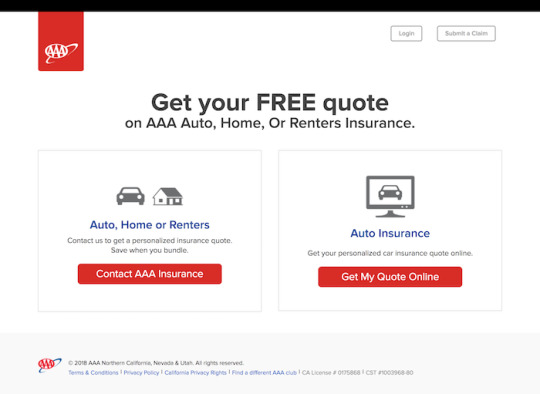
But if you want to rank organically, you’ll have to do it through content. So, your page that ranks well will look more like this and convert less…

It doesn’t mean SEO is bad. In reality, it’s much cheaper in the long run than paid ads and will produce a better ROI. But don’t just assume that if you get 100 visitors from paid ads and 3 purchases that you’ll have the same conversion rate with your SEO traffic.
Chances are it will be significantly lower by maybe 2 or 3x, but because SEO is cheaper, it will be much more profitable.
Lesson #6: Remarketing is one of the best ways to generate an ROI from SEO
If you get a ton of traffic from SEO, there is a simple strategy you can implement to boost your conversions.
Remarket everyone on Facebook, Google, and YouTube.
That way people come to your site, read your content, and build trust with you and your brand.
Then you remarket them throughout the web with ads that prompt your products or services and send them to a landing page that will drive sales.
I’ve been doing this for years, just look at my old remarketing ad…

For the regions I use remarketing in, it is responsible for 46% of my leads.
Lesson #7: Don’t forget to update your old content
I publish one new blog post a week. I’m working on increasing this as I get more time, but for now, it is one a week.
Can you guess how many blog posts I update on a daily basis? Technically it is 0 (me at least), but my team focuses on updating at least 3 old blog posts per day. That’s roughly 90 a month.
Once you have a few hundred pages, make sure you focus on updating your old content or else your traffic will quickly drop.
You can use this content decay tool to see which posts you should update first.
This will help you continually grow your SEO traffic instead of hitting plateaus or seeing your traffic take massive drops.
Lesson #8: Don’t forget to optimize your title tags
One of the easiest ways to grow your rankings is to optimize your title tags.
If you can write persuasive copy and get more clicks, you’ll quickly move up on Google.
In Brazil, we spend more time doing this than we do in the United States.
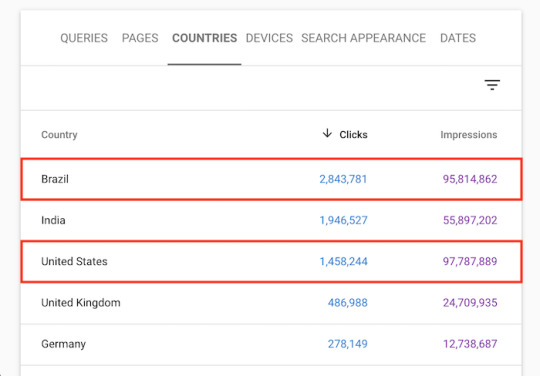
We get a similar amount of impressions in Brazil, but we have more people focusing on improving our title tags and testing. Hence, we get 95% more SEO traffic in Brazil.
If you want tips on boosting your clicks, check out this article.
Another simple hack is to use the “Content Ideas” report in Ubersuggest.

On the right side of that report, you can see social share counts from Facebook and Pinterest. And on the left side, you see titles of articles.
Typically, if people like a title they share it more. So, look for titles that have a lot of shares as it will give you ideas on what you can use on your website to get more clicks and boost your rankings.
Lesson #9: Don’t put dates in your URL
I used to put dates in my URLs like:
Neilpatel.com/2017/12/title-of-post/
This causes search engines to assume that your content is related to a specific date. And after that date gets old, search engines assume your content is irrelevant and outdated.
The moment I removed the date from my URLs, I grew my SEO traffic by 58% in 30 days.
youtube
If you have dates in your URL, make sure you 301 redirect your old URLs to your new ones once you make that change, or else your rankings will drop.
Lesson #10: Don’t be afraid to use popups
Don’t you hate popups? Well, who doesn’t?
But people use them because they work.
The majority of your pages that will rank are blog-related content. And blog posts tend to drive fewer direct conversions because people are on your site to read the content.
In order to maximize your conversions from SEO, you should consider using exit popups so you can convert more of those visitors into customers as they leave.
When you leave this site in most cases, you’ll see a popup that looks like:
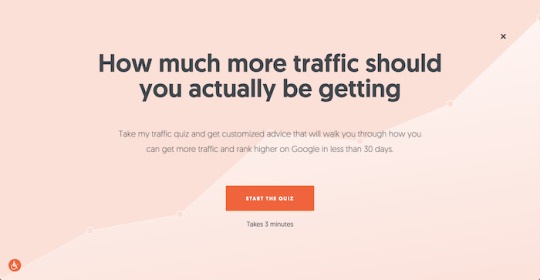
And it drives you to this quiz, which allows me to convert SEO visitors into customers.
You can easily copy me by using Hello Bar. It works for all industries including B2B and ecommerce and even lead generation sites.
Lesson #11: Brand queries affect rankings
Everyone talks about how you need links to boost rankings.
But very few people talk about brand queries.
As Google’s ex-CEO and ex-head of web spam both emphasized how brands are important.

One of the big reasons for my growth in SEO traffic is the growth in my brand. I’ve seen a direct correlation in which the more people who find me from my name, the more SEO traffic I get.
Just look at my brand growth over time:
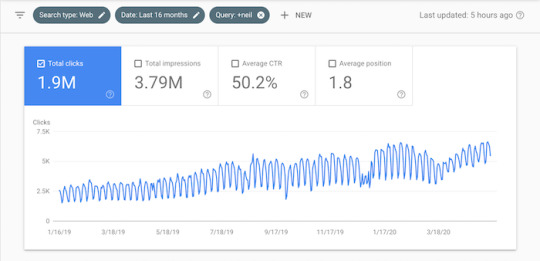
I’ve received over 1.9 million visitors over the last 16 months from people typing in variations of my name in Google.
Lesson #12: Don’t waste your money on paid links
I’ve been doing SEO since I was 16 years old. That’s a long time…
When I started off as a kid, I dabbled in paid links and I used to dominate Google for terms like online casino, online poker, web hosting, auto insurance, and even credit cards.
And I was making a killing off of affiliate income from these sites.
But it was all short lived.
Why?
Because I bought links. And eventually Google penalized all of those sites.
If I never purchased links, those sites would have taken longer to rank, but they would have been around today, and I would have generated more income overall.
Don’t buy links, it’s bad and shortsighted.
Lesson #13: Guest post to build a brand, not to build links
I already covered the importance of branding above.
A great way to build your brand and indirectly boost your SEO traffic is through guest posting.
But don’t use guest posting to build links.
Most sites that offer guest posts, nofollow them (which they should), and Google is smart enough to know what a guest post is, hence they ignore guest post links from sites like Forbes.
It’s pretty easy to spot a guest post for both a human and algorithm…

But if you are using it to build a brand, great. Focus on the content quality and not links.
Lesson #14: Don’t forget to interlink
Do you know what some of my highest ranked pages are?
The ones that are interlinked.
It takes anywhere from 6 months to a year for many of the interlinks to kick in, but it is still effective none-the-less.
Every time I wrote content, I used to make sure I link out to my older pieces of content when it made sense. But I made a big mistake… I wasn’t going into my older pieces of content and then adding links to my newer pieces of content.
That one change was game-changing for me. It took time to see the results but it worked exceptionally well.
It’s how I rank high for terms like “email marketing”.

Lesson #15: Google isn’t the only game in town
Although Google is the most popular search engine, it isn’t the only one you need to focus on.
Did you know that YouTube is the second most popular search engine?
Even Bing gets a lot of traffic.
If you want to rank high on Bing, follow this.
Or if you prefer video, watch this:
youtube
As for YouTube, this guide will teach you YouTube SEO. It works really well, just look at my YouTube SEO traffic:

Over the last 28 days, I received 429,501 video views through YouTube SEO.
Lesson #16: Speed is everything
The faster your server and the more optimized your site, the more traffic you’ll get.
Years ago, my friend Otis added more servers to his site GoodReads.
Within a month, his SEO traffic went up over 20%.
Speed is part of Google’s algorithm, so optimize it for both web and mobile.
A quick way to see your site’s speed is to enter your URL here.
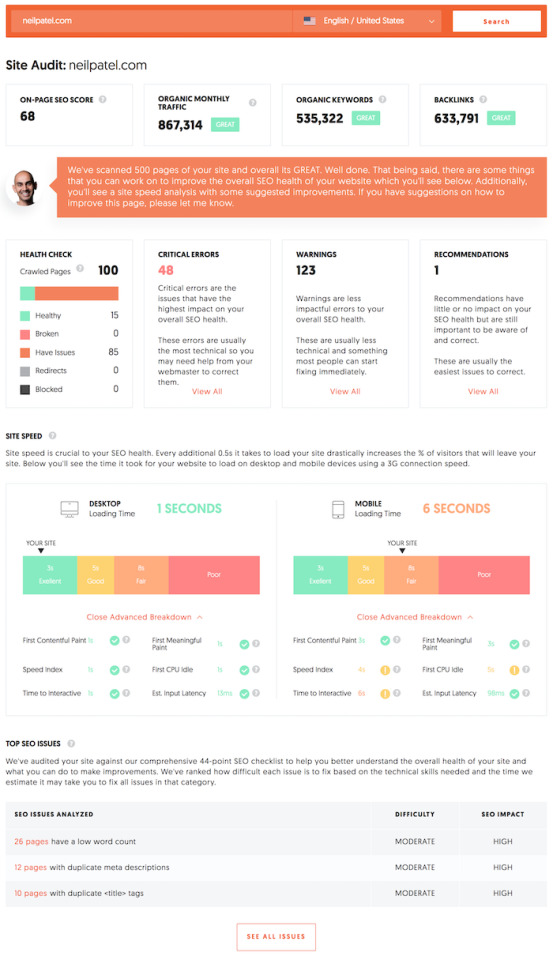
You’ll see a report that breaks down your mobile and desktop load times as well as what you can do to improve them.
Lesson #17: Quality over quantity
SEO used to be a game of quantity over quality.
That isn’t the case anymore. With over a billion blogs, Google has its fair share of sites to choose from.
Just look at About.com. Eventually they renamed it Dotdash and changed their strategy.
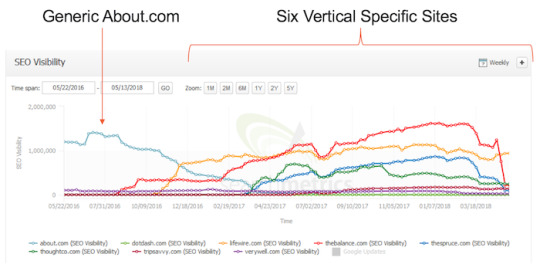
They took all of their About.com content and moved it over to 6 vertical based sites and deleted 900,000 pages of junk content.
This grew their traffic and revenue by a whopping 140%.
Focus on writing high-quality content. It’s why I blog less and try to make my content amazing.
Lesson #18: Tools are better than content marketing
I used to focus all of my energy on content marketing because it drove a lot of links and SEO traffic.
But over time, I realized that creating free tools builds more natural links than anything else I have ever tested.
Just look at Ubersuggest. I spent years creating it and look at how many links it has generated…
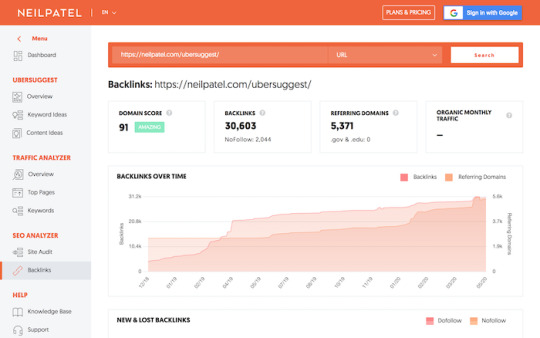
30,603 backlinks! That’s a lot of links.
If you don’t have the resources to build a custom tool like me, you can always start with buying a white label tool from Code Canyon for $10 or $20. They literally have tools for almost all industries.
Lesson #19: Don’t rely only on SEO
When I first got started in SEO, all I could think about was SEO.
To me, it was the best marketing channel out there because it allowed me to compete with large companies.
Even to this day, I still love SEO more than any other channel.
But it doesn’t stop me from leveraging other marketing channels.
See, years ago you could build a business off of one marketing channel.
Yelp was built through SEO. Dropbox through social media referrals. Facebook through email invites…
Those days don’t exist anymore. You can’t just build your traffic from one channel.
Although you should do SEO, you should also try paid ads, social media marketing, email marketing, push notifications, and anything else that comes out.
Diversify your traffic sources and don’t just rely solely on SEO.
Lesson #20: People love linking to data
Spending money and time to gather your own unique data is an easy way to build links.
Check out my posts on content marketing trends and social media trends.
I’ve added tons of unique data, stats, and charts to each of those posts.
The end result? Extra backlinks.

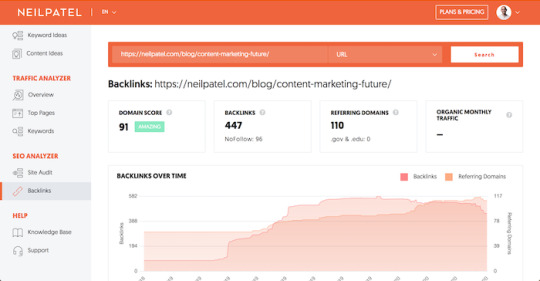
The content marketing trends post received 447 backlinks.
If you don’t have the time to gather custom data you can always find someone on Upwork to help you out.
Lesson #21: Don’t forget about Infographics
One of my favorite SEO strategies that still works well today is infographics.
I have tons of them on the NeilPatel.com blog.
I didn’t start off with infographics here… I used to do them on my old blog Quick Sprout and KISSmetrics.
Here’s an interesting stat for you when I used to crank out infographics on KISSmetrics.
Within a two-year period, from 2010 to 2012, 47 infographics generated 2,512,596 visitors and 41,142 backlinks from 3,741 unique domains. They also generated 41,359 tweets and 20,859 likes.
If you don’t have money to hire a designer, you can use Infogram or Canva to create one on your own.
Lesson #22: Google doesn’t penalize for duplicate content
You don’t want to post tons of duplicate content on your site as it’s not the best user experience, but keep in mind that Google doesn’t penalize you for duplication.
They may not just rank the duplicate content as well.
So, if you spend all of this time producing amazing, unique content, why not publish it FIRST on your own website.
Then after a few hours or days if you want to be safe, take that exact content and publish it on Facebook, LinkedIn, and anywhere else that will accept your content.
Literally, take all of the words and paste them onto those social channels.
It will get you extra awareness and branding. Plus, the content should already be indexed on your site, so Google knows it came from your first… and I doubt you care if the duplicated version on LinkedIn ranks. That’s still great branding.
In other words, don’t be afraid to repurpose your content even if it causes duplication.
Just look at this post, for example. I’m also repurposing it into a 4-part podcast series.
Lesson #23: Don’t recreate the wheel
I used to spend hours a week doing keyword research trying to figure out what new terms to rank for.
Eventually, I figured out an easier and better way to find new content topics and keywords to go after.
Go to Ubersuggest, type in your competitor’s domain name and hit search.
In the left-hand navigation click on Top Pages.

You’ll see a report that shows you all of the popular pages on your competition’s website. This will give you ideas for the type of pages you should create on your website.

Then I want you to click “View All” under Est. Visits (estimated visits). This will show you all of the keywords that drive traffic to that page.

You now have a list of topics and keywords for each topic to go after.
Lesson #24: Don’t pick a generic domain name
Remember how in Lesson 11 I talked about brand queries and how they helped rankings?
After I learned that, I decided to go buy exact match domain names where the domain name was the keyword.
That way I would get lots of brand queries without trying.
Well, there’s an issue… even if you rank high, what you’ll find is you will have a low click-through rate in most cases.
If you have a low click-through rate, it tells Google your brand isn’t strong and people don’t prefer it, which can hurt your ranking.
So instead of focusing on exact match domains, unless you have millions to spend on branding like Hotels.com, focus on building a memorable brand.
youtube
Pick something that is unique, easy to spell, and easy to remember.
Lesson #25: Learn from blackhat SEOs, but don’t go over to the dark side
Blackhat SEOs come up with some interesting data and experiments.
Many of them don’t work for long, but they are interesting none-the-less.
Although I don’t recommend practicing blackhat SEO, I do recommend following them.
The easiest way you can learn from them is by reading Blackhat World.
People there share some interesting insights, especially every time there is a major Google algorithm update.
Again, I don’t recommend practicing blackhat SEO, but following them may help you uncover “white hat” techniques that can increase your rankings. Not everything they do is bad… many of them use legitimate tactics as well.
Lesson #26: Short URLs rank better than long ones
My URLs used to be the title of my blog post.
For example, with this post I would have used this URL in the past…
Neilpatel.com/blog/30-lessons-after-30-million-seo-visitors/
Eventually I switched to short URLs.
Google just prefers them. And I’ve seen it firsthand. That’s why I use short ones now.
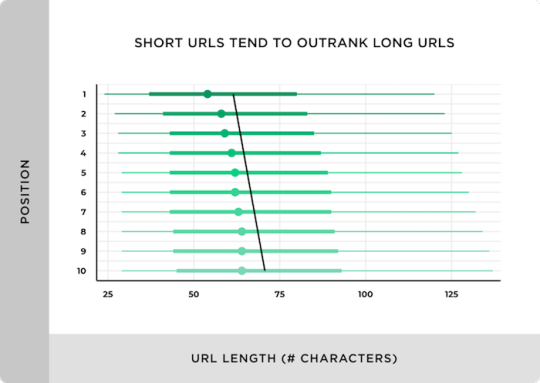
URLs at position #1 are on average 9.2 characters shorter than URLs that rank in position #10. So, keep them short.
Lesson #27: The power’s in the list
If you want your content to rank high on Google, you need more people to see it.
Whether it is from social shares, or from push notifications or email blasts… the more people that see your content, the more engagement it will get, and the more people that will link to it.
I used to do a ton of manual outreach every time I published a new blog post and I would email people asking them to link to me.
And it works, it’s just time consuming and a pain.
These days, I have a better strategy… send out an email blast every time I publish a new post.

I can now get anywhere from 20,000 to 50,000 clicks per email I send out.
Now of course you won’t get that from day one as it took me years to build up my email list.
But you can start today by collecting emails. You can easily do that through Hello Bar.
And as your list grows, so will the clicks to your blog and the number of links you get, which in turn will increase your rankings.
Lesson #28: Don’t let your foot off the peddle
This was one of the hardest lessons I learned.
It’s exhausting to continually blog and do your own SEO. Sometimes you just want a break.
With my old blog, Quick Sprout, I used to publish 12 blog posts a month and I did that consistently for 3 years.
One day I decided that I wanted to stop for a month. So, I took a 30-day break.
Guess what happened to my traffic?
It tanked by 32%.
So, then I started blogging again. And guessed what happened to my traffic after I started blogging?
It didn’t come right back.
It took me 3 months to get back to where I was.
When things are working for you, don’t slow down. Keep pushing harder, even if you are exhausted. Because the moment you stop, you’ll drop, and it is a lot of work to get back to where you were.
Lesson #29: The best SEO advice comes from conferences
The best SEO advice I have ever learned over the years has come from conferences.
And no, I don’t mean by sitting in on the sessions, although you can learn from those too.
The best SEO secrets and advice I learned came from networking. When you go to these conferences, hundreds if not thousands of other SEOs are there. And when you go to the bar after hours and mingle with people, you’ll quickly pick stuff up.
You’ll be shocked at what people tell you. It’s how I learned a lot of the good tactics that I still use today.
Lesson #30: Never stop learning
This one may sound obvious but when things are going well, people get complacent.
Google makes on average 3,234 updates per year and that count has been increasing over time.
Just think about that for a bit… that’s roughly 9 algorithm updates per day.
Because they are changing so quickly, you won’t survive if you don’t stay up to date.
Yes, the ideal strategy is to do what’s best for your users or visitors as in the long run, Google wants to promote those sites, but it doesn’t mean that you can ignore the changes happening in the industry.
Read all of the SEO blogs out there, attend conferences as I mentioned above… experiment on test sites… push yourself to be better.
That drive of always improving and always wanting to learn more has helped me tremendously. It’s one of the reasons for my growth in rankings over the years.
Conclusion
There are a lot of lessons that you will learn as your rankings grow and as you spend more time on SEO.
But hopefully, you don’t have to waste time and go through the same mistakes I made. You don’t want to learn these lessons the hard way.
That’s why I decided to share them. I want to save you the time and help you achieve your traffic goals faster.
Which SEO lessons have you learned?
The post 30 Lessons After 30 Million SEO Visitors appeared first on Neil Patel.
Original content source: https://neilpatel.com/blog/seo-visitors/ via https://neilpatel.com
The original post, 30 Lessons After 30 Million SEO Visitors, has been shared from https://imtrainingparadise.wordpress.com/2020/05/19/30-lessons-after-30-million-seo-visitors/ via https://imtrainingparadise.wordpress.com
0 notes
Text
30 Lessons After 30 Million SEO Visitors

As you can see from the screenshot above, I’ve driven 30 million visitors to my website from SEO.
Technically it’s more, but who’s counting.
What’s funny, though, is I barely look at my traffic, even as Google continually rolls out algorithm updates.
I know that sounds contradictory because if you are an SEO, why wouldn’t you obsess about traffic, right?
Well, it’s because I’ve learned some hard lessons over the year… mainly because I’ve made a lot of mistakes.
So today, I wanted to share them with you so that you can learn from my mistakes… so here goes:
Lesson #1: Don’t obsess over rankings, obsess over conversions
I used to check my rankings every single day. Literally.
On top of that, I would log into Google Analytics 4 to 5 times a day and continually check my traffic.
That’s all I cared about back in the day… boosting my organic traffic.
But here is the thing: As my rankings and traffic went up over the years, my revenue didn’t go up proportionally.
For example, during one quarter in 2017, my SEO traffic went up 39.52%, but my revenue from SEO went up only 4.29%.
I quickly learned that traffic isn’t everything. If you can’t convert the traffic into revenue it doesn’t matter.
That taught me that you need to focus on the right keywords that drive conversions and continually optimize your site for conversions.
An easy first step for you to take is to install Crazy Egg and run a heatmap to see where people click so you adjust your design and copy to get more sales.

Lesson #2: The easiest way to grow your SEO traffic is international expansion
You already know that I get a lot of SEO traffic, but do you know what country drives most of my traffic?
If you guessed United States, you are wrong.
Brazil is my most popular region, followed by India.

International SEO is the easiest way to expand and grow your traffic. Here are a few posts that you should read before you expand your SEO globally:
How to create a global SEO strategy
Fundamentals of international SEO
How to correctly setup your site for international SEO
How to profitably expand your SEO globally
Lesson #3: Keywords are very, very, very, very important
When I used to write my content, I didn’t obsess about the keywords when I should have.
My team actually proved me wrong on this.
I used to focus on writing content for humans and didn’t worry about search engines. My team, on the other hand, obsesses about keywords.
Just look at the growth of our traffic in Brazil because of our obsession with the right keywords.

One simple thing I do before writing that has really helped is I head over to Ubersuggest and type in a few of the keywords that I want to go after.

Once it loads, you’ll see a report like the one above. I want you to then click on “Keyword Ideas” in the left-hand navigation.

You’ll see a report that contains a list of keywords that you could potentially be targeting.

Make sure you click on the “Related” tab, as well as “Questions” and “Comparisons” … scroll through the list. You’ll see hundreds of keywords. Pick all of the ones that are relevant and ideally have a high cost per click (CPC). These are the keywords that’ll not only drive traffic but revenue as well.
Whenever I write a blog post, I go through this step. Every single time.
Lesson #4: AMP pages can drive more SEO traffic
AMP pages load faster on mobile devices than non-AMP pages.
If you aren’t familiar with the AMP framework, read this.
What most people won’t tell you about AMP pages is that:
In regions like the United States, Canada, and the United Kingdom, countries with decent Internet infrastructure, you won’t see much of an increase in traffic.
In regions with poor Internet infrastructure, like Brazil, you’ll see a 10 to 15% lift in mobile SEO traffic by having AMP pages.
AMP pages don’t convert visitors into customers as well as normal responsive web design. So, you’ll have to work on testing your AMP pages so you can boost your conversion rates.
Lesson #5: SEO will never convert as well as paid ads
When I started off with SEO, I would run projections on how much the traffic would make me.
But the numbers were always off, even if I was able to get the rankings.
Here’s the main reason: If you are bidding on terms like auto insurance through ads, you can drive people to a landing page that looks like this:

But if you want to rank organically, you’ll have to do it through content. So, your page that ranks well will look more like this and convert less…

It doesn’t mean SEO is bad. In reality, it’s much cheaper in the long run than paid ads and will produce a better ROI. But don’t just assume that if you get 100 visitors from paid ads and 3 purchases that you’ll have the same conversion rate with your SEO traffic.
Chances are it will be significantly lower by maybe 2 or 3x, but because SEO is cheaper, it will be much more profitable.
Lesson #6: Remarketing is one of the best ways to generate an ROI from SEO
If you get a ton of traffic from SEO, there is a simple strategy you can implement to boost your conversions.
Remarket everyone on Facebook, Google, and YouTube.
That way people come to your site, read your content, and build trust with you and your brand.
Then you remarket them throughout the web with ads that prompt your products or services and send them to a landing page that will drive sales.
I’ve been doing this for years, just look at my old remarketing ad…

For the regions I use remarketing in, it is responsible for 46% of my leads.
Lesson #7: Don’t forget to update your old content
I publish one new blog post a week. I’m working on increasing this as I get more time, but for now, it is one a week.
Can you guess how many blog posts I update on a daily basis? Technically it is 0 (me at least), but my team focuses on updating at least 3 old blog posts per day. That’s roughly 90 a month.
Once you have a few hundred pages, make sure you focus on updating your old content or else your traffic will quickly drop.
You can use this content decay tool to see which posts you should update first.
This will help you continually grow your SEO traffic instead of hitting plateaus or seeing your traffic take massive drops.
Lesson #8: Don’t forget to optimize your title tags
One of the easiest ways to grow your rankings is to optimize your title tags.
If you can write persuasive copy and get more clicks, you’ll quickly move up on Google.
In Brazil, we spend more time doing this than we do in the United States.

We get a similar amount of impressions in Brazil, but we have more people focusing on improving our title tags and testing. Hence, we get 95% more SEO traffic in Brazil.
If you want tips on boosting your clicks, check out this article.
Another simple hack is to use the “Content Ideas” report in Ubersuggest.

On the right side of that report, you can see social share counts from Facebook and Pinterest. And on the left side, you see titles of articles.
Typically, if people like a title they share it more. So, look for titles that have a lot of shares as it will give you ideas on what you can use on your website to get more clicks and boost your rankings.
Lesson #9: Don’t put dates in your URL
I used to put dates in my URLs like:
Neilpatel.com/2017/12/title-of-post/
This causes search engines to assume that your content is related to a specific date. And after that date gets old, search engines assume your content is irrelevant and outdated.
The moment I removed the date from my URLs, I grew my SEO traffic by 58% in 30 days.
youtube
If you have dates in your URL, make sure you 301 redirect your old URLs to your new ones once you make that change, or else your rankings will drop.
Lesson #10: Don’t be afraid to use popups
Don’t you hate popups? Well, who doesn’t?
But people use them because they work.
The majority of your pages that will rank are blog-related content. And blog posts tend to drive fewer direct conversions because people are on your site to read the content.
In order to maximize your conversions from SEO, you should consider using exit popups so you can convert more of those visitors into customers as they leave.
When you leave this site in most cases, you’ll see a popup that looks like:

And it drives you to this quiz, which allows me to convert SEO visitors into customers.
You can easily copy me by using Hello Bar. It works for all industries including B2B and ecommerce and even lead generation sites.
Lesson #11: Brand queries affect rankings
Everyone talks about how you need links to boost rankings.
But very few people talk about brand queries.
As Google’s ex-CEO and ex-head of web spam both emphasized how brands are important.

One of the big reasons for my growth in SEO traffic is the growth in my brand. I’ve seen a direct correlation in which the more people who find me from my name, the more SEO traffic I get.
Just look at my brand growth over time:

I’ve received over 1.9 million visitors over the last 16 months from people typing in variations of my name in Google.
Lesson #12: Don’t waste your money on paid links
I’ve been doing SEO since I was 16 years old. That’s a long time…
When I started off as a kid, I dabbled in paid links and I used to dominate Google for terms like online casino, online poker, web hosting, auto insurance, and even credit cards.
And I was making a killing off of affiliate income from these sites.
But it was all short lived.
Why?
Because I bought links. And eventually Google penalized all of those sites.
If I never purchased links, those sites would have taken longer to rank, but they would have been around today, and I would have generated more income overall.
Don’t buy links, it’s bad and shortsighted.
Lesson #13: Guest post to build a brand, not to build links
I already covered the importance of branding above.
A great way to build your brand and indirectly boost your SEO traffic is through guest posting.
But don’t use guest posting to build links.
Most sites that offer guest posts, nofollow them (which they should), and Google is smart enough to know what a guest post is, hence they ignore guest post links from sites like Forbes.
It’s pretty easy to spot a guest post for both a human and algorithm…

But if you are using it to build a brand, great. Focus on the content quality and not links.
Lesson #14: Don’t forget to interlink
Do you know what some of my highest ranked pages are?
The ones that are interlinked.
It takes anywhere from 6 months to a year for many of the interlinks to kick in, but it is still effective none-the-less.
Every time I wrote content, I used to make sure I link out to my older pieces of content when it made sense. But I made a big mistake… I wasn’t going into my older pieces of content and then adding links to my newer pieces of content.
That one change was game-changing for me. It took time to see the results but it worked exceptionally well.
It’s how I rank high for terms like “email marketing”.

Lesson #15: Google isn’t the only game in town
Although Google is the most popular search engine, it isn’t the only one you need to focus on.
Did you know that YouTube is the second most popular search engine?
Even Bing gets a lot of traffic.
If you want to rank high on Bing, follow this.
Or if you prefer video, watch this:
youtube
As for YouTube, this guide will teach you YouTube SEO. It works really well, just look at my YouTube SEO traffic:

Over the last 28 days, I received 429,501 video views through YouTube SEO.
Lesson #16: Speed is everything
The faster your server and the more optimized your site, the more traffic you’ll get.
Years ago, my friend Otis added more servers to his site GoodReads.
Within a month, his SEO traffic went up over 20%.
Speed is part of Google’s algorithm, so optimize it for both web and mobile.
A quick way to see your site’s speed is to enter your URL here.

You’ll see a report that breaks down your mobile and desktop load times as well as what you can do to improve them.
Lesson #17: Quality over quantity
SEO used to be a game of quantity over quality.
That isn’t the case anymore. With over a billion blogs, Google has its fair share of sites to choose from.
Just look at About.com. Eventually they renamed it Dotdash and changed their strategy.

They took all of their About.com content and moved it over to 6 vertical based sites and deleted 900,000 pages of junk content.
This grew their traffic and revenue by a whopping 140%.
Focus on writing high-quality content. It’s why I blog less and try to make my content amazing.
Lesson #18: Tools are better than content marketing
I used to focus all of my energy on content marketing because it drove a lot of links and SEO traffic.
But over time, I realized that creating free tools builds more natural links than anything else I have ever tested.
Just look at Ubersuggest. I spent years creating it and look at how many links it has generated…

30,603 backlinks! That’s a lot of links.
If you don’t have the resources to build a custom tool like me, you can always start with buying a white label tool from Code Canyon for $10 or $20. They literally have tools for almost all industries.
Lesson #19: Don’t rely only on SEO
When I first got started in SEO, all I could think about was SEO.
To me, it was the best marketing channel out there because it allowed me to compete with large companies.
Even to this day, I still love SEO more than any other channel.
But it doesn’t stop me from leveraging other marketing channels.
See, years ago you could build a business off of one marketing channel.
Yelp was built through SEO. Dropbox through social media referrals. Facebook through email invites…
Those days don’t exist anymore. You can’t just build your traffic from one channel.
Although you should do SEO, you should also try paid ads, social media marketing, email marketing, push notifications, and anything else that comes out.
Diversify your traffic sources and don’t just rely solely on SEO.
Lesson #20: People love linking to data
Spending money and time to gather your own unique data is an easy way to build links.
Check out my posts on content marketing trends and social media trends.
I’ve added tons of unique data, stats, and charts to each of those posts.
The end result? Extra backlinks. 🙂

The content marketing trends post received 447 backlinks.
If you don’t have the time to gather custom data you can always find someone on Upwork to help you out.
Lesson #21: Don’t forget about Infographics
One of my favorite SEO strategies that still works well today is infographics.
I have tons of them on the NeilPatel.com blog.
I didn’t start off with infographics here… I used to do them on my old blog Quick Sprout and KISSmetrics.
Here’s an interesting stat for you when I used to crank out infographics on KISSmetrics.
Within a two-year period, from 2010 to 2012, 47 infographics generated 2,512,596 visitors and 41,142 backlinks from 3,741 unique domains. They also generated 41,359 tweets and 20,859 likes.
If you don’t have money to hire a designer, you can use Infogram or Canva to create one on your own.
Lesson #22: Google doesn’t penalize for duplicate content
You don’t want to post tons of duplicate content on your site as it’s not the best user experience, but keep in mind that Google doesn’t penalize you for duplication.
They may not just rank the duplicate content as well.
So, if you spend all of this time producing amazing, unique content, why not publish it FIRST on your own website.
Then after a few hours or days if you want to be safe, take that exact content and publish it on Facebook, LinkedIn, and anywhere else that will accept your content.
Literally, take all of the words and paste them onto those social channels.
It will get you extra awareness and branding. Plus, the content should already be indexed on your site, so Google knows it came from your first… and I doubt you care if the duplicated version on LinkedIn ranks. That’s still great branding.
In other words, don’t be afraid to repurpose your content even if it causes duplication.
Just look at this post, for example. I’m also repurposing it into a 4-part podcast series.
Lesson #23: Don’t recreate the wheel
I used to spend hours a week doing keyword research trying to figure out what new terms to rank for.
Eventually, I figured out an easier and better way to find new content topics and keywords to go after.
Go to Ubersuggest, type in your competitor’s domain name and hit search.
In the left-hand navigation click on Top Pages.

You’ll see a report that shows you all of the popular pages on your competition’s website. This will give you ideas for the type of pages you should create on your website.
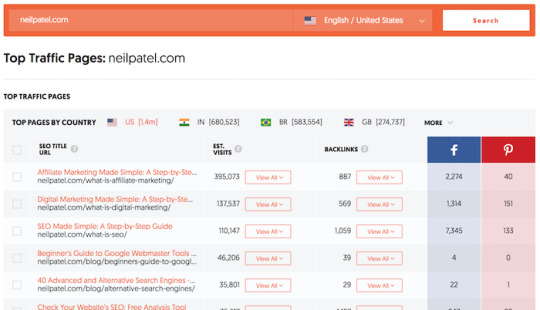
Then I want you to click “View All” under Est. Visits (estimated visits). This will show you all of the keywords that drive traffic to that page.

You now have a list of topics and keywords for each topic to go after.
Lesson #24: Don’t pick a generic domain name
Remember how in Lesson 11 I talked about brand queries and how they helped rankings?
After I learned that, I decided to go buy exact match domain names where the domain name was the keyword.
That way I would get lots of brand queries without trying.
Well, there’s an issue… even if you rank high, what you’ll find is you will have a low click-through rate in most cases.
If you have a low click-through rate, it tells Google your brand isn’t strong and people don’t prefer it, which can hurt your ranking.
So instead of focusing on exact match domains, unless you have millions to spend on branding like Hotels.com, focus on building a memorable brand.
youtube
Pick something that is unique, easy to spell, and easy to remember.
Lesson #25: Learn from blackhat SEOs, but don’t go over to the dark side
Blackhat SEOs come up with some interesting data and experiments.
Many of them don’t work for long, but they are interesting none-the-less.
Although I don’t recommend practicing blackhat SEO, I do recommend following them.
The easiest way you can learn from them is by reading Blackhat World.
People there share some interesting insights, especially every time there is a major Google algorithm update.
Again, I don’t recommend practicing blackhat SEO, but following them may help you uncover “white hat” techniques that can increase your rankings. Not everything they do is bad… many of them use legitimate tactics as well.
Lesson #26: Short URLs rank better than long ones
My URLs used to be the title of my blog post.
For example, with this post I would have used this URL in the past…
Neilpatel.com/blog/30-lessons-after-30-million-seo-visitors/
Eventually I switched to short URLs.
Google just prefers them. And I’ve seen it firsthand. That’s why I use short ones now.

URLs at position #1 are on average 9.2 characters shorter than URLs that rank in position #10. So, keep them short.
Lesson #27: The power’s in the list
If you want your content to rank high on Google, you need more people to see it.
Whether it is from social shares, or from push notifications or email blasts… the more people that see your content, the more engagement it will get, and the more people that will link to it.
I used to do a ton of manual outreach every time I published a new blog post and I would email people asking them to link to me.
And it works, it’s just time consuming and a pain.
These days, I have a better strategy… send out an email blast every time I publish a new post.

I can now get anywhere from 20,000 to 50,000 clicks per email I send out.
Now of course you won’t get that from day one as it took me years to build up my email list.
But you can start today by collecting emails. You can easily do that through Hello Bar.
And as your list grows, so will the clicks to your blog and the number of links you get, which in turn will increase your rankings.
Lesson #28: Don’t let your foot off the peddle
This was one of the hardest lessons I learned.
It’s exhausting to continually blog and do your own SEO. Sometimes you just want a break.
With my old blog, Quick Sprout, I used to publish 12 blog posts a month and I did that consistently for 3 years.
One day I decided that I wanted to stop for a month. So, I took a 30-day break.
Guess what happened to my traffic?
It tanked by 32%.
So, then I started blogging again. And guessed what happened to my traffic after I started blogging?
It didn’t come right back.
It took me 3 months to get back to where I was.
When things are working for you, don’t slow down. Keep pushing harder, even if you are exhausted. Because the moment you stop, you’ll drop, and it is a lot of work to get back to where you were.
Lesson #29: The best SEO advice comes from conferences
The best SEO advice I have ever learned over the years has come from conferences.
And no, I don’t mean by sitting in on the sessions, although you can learn from those too.
The best SEO secrets and advice I learned came from networking. When you go to these conferences, hundreds if not thousands of other SEOs are there. And when you go to the bar after hours and mingle with people, you’ll quickly pick stuff up.
You’ll be shocked at what people tell you. It’s how I learned a lot of the good tactics that I still use today.
Lesson #30: Never stop learning
This one may sound obvious but when things are going well, people get complacent.
Google makes on average 3,234 updates per year and that count has been increasing over time.
Just think about that for a bit… that’s roughly 9 algorithm updates per day.
Because they are changing so quickly, you won’t survive if you don’t stay up to date.
Yes, the ideal strategy is to do what’s best for your users or visitors as in the long run, Google wants to promote those sites, but it doesn’t mean that you can ignore the changes happening in the industry.
Read all of the SEO blogs out there, attend conferences as I mentioned above… experiment on test sites… push yourself to be better.
That drive of always improving and always wanting to learn more has helped me tremendously. It’s one of the reasons for my growth in rankings over the years.
Conclusion
There are a lot of lessons that you will learn as your rankings grow and as you spend more time on SEO.
But hopefully, you don’t have to waste time and go through the same mistakes I made. You don’t want to learn these lessons the hard way.
That’s why I decided to share them. I want to save you the time and help you achieve your traffic goals faster.
Which SEO lessons have you learned?
The post 30 Lessons After 30 Million SEO Visitors appeared first on Neil Patel.
Original content source: https://ift.tt/2zcTaTl via https://neilpatel.com The post, 30 Lessons After 30 Million SEO Visitors, has been shared from https://ift.tt/2WJNUQh via https://ift.tt/2r0Go64
0 notes
Photo

#나의첫유튜브프로젝트 #토이푸딩 #김세진 #박종한 #다산북스 #브랜드 #키워드 #썸네일 #googleads #upload #creator #contents #remarketing #hashtag #seo #cta #japan #life #세줄평 20/3/13-25 한 완구 회사의 뉴미디어팀 김대리가 회사 #유튜브 채���을 개설하고 결국 개인 채널 #인플루언서 까지 되는 ��토리가 있고 각 장마다 실전 유튜브라는 실습 및 요약 코너도 있다 ある玩具会社のニューメディアチームの金代理が会社#YouTube チャンネルを開設して、最終的に個人チャンネルの#influencer までなるストーリーがあり、各章ごとに実戦#YouTube という実習コーナーもある 채널을 개설하고 성장시키고수익을 창출하는 과정을 채널 시청자나 유튜브 그리고 #광고주 의 입장에서 다각도로 분석했다 #チャンネル を開設して成長させ、収益を創出する過程をチャンネル視聴者やYouTube、そして広告主の立場から多角的に分析した #유튜버 되기에 큰 흥미가 없다면 실습편을 생략하고 뉴미디어팀 부장의 퇴직, 차장의 전직,인턴 사원의 고뇌, 김대리의 연민 등 중요 에피소드 만을 읽어도 충분할지 모른다 #Youtuber になることにあまり興味がない場合は実習編を省略してニューメディアチーム部長の退職、次長の転職、インターン社員の苦悩、金代理の愛と悩みなどの重要エピソードだけ読んでも十分かもしれない (at Nagoya-shi, Aichi, Japan) https://www.instagram.com/p/B-J8wRJgU-o/?igshid=oskt1j5ujol5
#나의첫유튜브프로젝트#토이푸딩#김세진#박종한#다산북스#브랜드#키워드#썸네일#googleads#upload#creator#contents#remarketing#hashtag#seo#cta#japan#life#세줄평#유튜브#인플루언서#youtube#influencer#광고주#チャンネル#유튜버#youtuber
0 notes
Text
25 Places to Promote Your New Product Online
Across the globe, customer journeys now merge the online and in-store experiences. E-commerce is now a force in business and is growing significantly every year. In 2018, U.S. online retail sales of physical goods equaled $501 billion. By 2023, that number is projected to surpass $740 billion in the U.S. alone, and will account for 15% of all specialty retails sales in North America.
The best e-commerce marketing strategy looks for out-of-the-box opportunities to get a brand and its products in front of more people. (See how Big Leap and Nomatic used creative strategies for explosive growth.) Here are 25 places you can promote your new product online to get those creative juices flowing.
1. Your Website
Your website is the one place online where you control everything. You can decide how to promote your new product, test different approaches, and really fine tune the customer experience.
2. Your Blog
Don’t have a blog? You should. Research finds that marketers who prioritize blogging efforts are 13x more likely to see positive ROI. Not only does a blog give you a platform to promote your new product, but it helps with lead generation, brand awareness, SEO, and establishing authority.
3. Your Social Media Profiles
As of January 2019, 45% of the world’s population (almost 3.5 billion people) are on social media, and 54% of them use it to research products. Find out which social networks are the best for your business.
4. Customer Reviews
Research shows that 97% of consumers factor reviews into their buying decisions. Encourage customers to review your new product and those reviews can show up in various places online, including Google, Facebook, review sites, and in search results.
5. Social Media Stories
Social media stories are on the rise (the use of social media stories has grown 842% since 2016) and are now on several platforms. They offer a unique opportunity for brands to engage with their audience.
6. Google My Business
You can post about your new product to your Google My Business profile as a promotion, by uploading photos to your profile, or posting FAQs.
7. Influencers/Bloggers
Ask authoritative influencers or bloggers to feature or review your product. You can facilitate this by sending free samples to those who are related to your industry.
8. Social Media Paid Ads
Social media advertising, while not free, provides a cost-effective opportunity for reaching the right demographics for your business. Facebook, in particular, has the most developed advertising platform with extensive targeting and Instagram placement.
9. Google Shopping
A great place to promote your products is through Google Shopping results. Sign up to the Google Merchant Center and upload your product data. This gives you access to paid and unpaid channels across Google.
10. Press Releases
The right press release can attract attention online. Media outlets are inundated with press releases every day, so make sure yours is well-written and newsworthy. TIP: Simply announcing that you have a new product is not newsworthy. Look for an angle that would interest the average reader.
11. Email
Research by MarketingSherpa found that marketers estimated the ROI from email marketing programs to be an impressive 119% ROI. The successful use of email in ecommerce digital marketing is alive and kicking.
12. Google Remarketing Ads
A remarketing ad is one that is shown to users after a person has visited your website. Google puts a cookie on the visitor’s computer that triggers the ad in various places online.
13. Daily Deals
Daily deal sites like Groupon and Living Social have immense followings and can help you acquire new customers and create brand awareness.
14. YouTube
There are 2 billion people who watch YouTube videos. Consider producing a product or how-to video to take advantage of this massive platform.
15. Display Ads
Use display ads to get your product across millions of websites. The Google Display Network claims to reach 90% of Internet users worldwide.
16. Amazon
Amazon is the top e-commerce platform in the country (49% of U.S. e-commerce market share) and smart businesses capitalize on this by becoming third-party sellers through Amazon Business.
17. Gift Guides
Chances are everyone you know has at one point searched online for gift ideas. Reach out to authors of existing lists to see about adding your product, or make a list of your own.
18. Review Sites
Add your business to review sites like Yelp, Foursquare, Angie’s List, and TripAdvisor. This gives your customers more places to leave reviews and, in a way, they promote your product.
19. Medium/Quora
Post meaningful content sites like Medium and Quora to boost your authority. With the right strategy, you can also promote your products and increase organic search traction.
20. Forums/Groups
Forums that relate to your industry, and Facebook and LinkedIn groups, are a great way for connecting with customers or other industry professionals. Interact on public forums, groups, and fan pages relevant to your niche and increase brand awareness.
21. Host A Contest or Giveaway
When run well, contests or giveaways can be an effective way to get your brand in front of a lot of potential customers.
22. Uncrate/Product Hunt
Uncrate and Product Hunt are product curation websites with loyal followings. If your product is the right kind, getting featured on either of these sites can drive significant sales.
23. Comparison Shopping Engines
Consumers use comparison shopping engines, also known as price comparison websites, to find multiple retailers offering the product they want to buy. Google Shopping, Pricegrabber, Shopping.com, and Shopzilla are all comparison sites.
24. Reddit
Become active on Reddit and document your product launch. You can attract followers and customers through giving advice, updates, and inside information.
25. Periscope
Many businesses promote themselves with this live-streaming tool. Use Periscope to offer a demo of your product, answer questions, or go behind the scenes of your company.
Take Your E-Commerce Marketing to the Next Level
For e-commerce, being found online is everything. But with millions of ecommerce sites in the world that can be challenging. Partnering with the e-commerce and SEO specialists at Big Leap can give you the competitive edge you need. Contact us today to see what we can do for your business.
The post 25 Places to Promote Your New Product Online appeared first on Big Leap.
0 notes
Photo

👊Acesso Imediato a TUDO Treinamento Completo Formula Negócio Online Direito ao Suporte VIP Completo Direito a Todas as Atualizações BÔNUS ESPECIAL 01: . Aulas Ao Vivo Comigo e Equipe BÔNUS ESPECIAL 02: Grupo VIP de Alunos BÔNUS ESPECIAL 03: . Método Venda Rápida BÔNUS ESPECIAL 04: . Copy Expert - Treinamento De Copywriting BÔNUS ESPECIAL 05: . ChatoBot Expert - Criar Audiência e Vendas Sem Investir Nada BÔNUS ESPECIAL 06: . Email Marketing Gratuito BÔNUS ESPECIAL 07: . Instagram Para Afiliados BÔNUS ESPECIAL 08: . Youtube Para Afiliados BÔNUS ESPECIAL 09: Youtube Sem Aparecer BÔNUS ESPECIAL 10: . Facebook Ads Para Afiliados BÔNUS ESPECIAL 11: . Google Ads Para Afiliados BÔNUS ESPECIAL 12: . Remarketing Para Afiliados BÔNUS ESPECIAL 13: . MiniSites Para Afiliados BÔNUS ESPECIAL 14: . Futuro Dos Afiliados (O Que Fazer Exatamente) BÔNUS ESPECIAL 15: . Desafio - Plano de Ação 60 Dias Para Ser TOP Afiliado BÔNUS ESPECIAL 16: . Lançamento de Produtos (Criação, Lançamento e Venda) BÔNUS ESPECIAL 17: . Marketing Digital Para Produtos Físicos E Serviços BÔNUS ESPECIAL 18: . Central de Ferramentas Exclusivas BÔNUS ESPECIAL 19: . Estudos de Caso Com Alunos de Sucesso BÔNUS ESPECIAL 20: . "CARTÃO OURO" Acesso a Novos Bônus e Conteúdos Certificado de Conclusão Mapas Mentais, PDFs, Resumos, Checklists etc. Para Download NOVO: Acompanhamento do Projeto para Implementação e Resultados Garantia Total de 7 Dias ou Seu Dinheiro de Volta. ACESSE O LINK NA BIO DO MEU INTEGRAM 👇👇 @INSTA.MIGUELALVESBAHIA . FÓRMULA NEGÓCIO ONLINE (PROMOÇÃO) E GARANTA JÁ A SUA VAGA OFERTA PROMOCIONAL ESTE MÊS DE NOVEMBRO. . UM FORTE ABRAÇO À TODOS MIGUEL ALVES EMPREENDEDORIMO DIGITAL https://www.instagram.com/p/B5XtaPslRAN/?igshid=1szu2rius07nq
0 notes
Text
Até a meia noite de hoje ou já era! R$ 150 de DESCONTO no Fórmula Negócio Online

Se você tem interesse em construir um negócio online sólido e de resultados escaláveis, a OPORTUNIDADE é agora!
O Alex Vargas liberou uma SUPER PROMOÇÃO DO DIA DOS PAIS!
O Fórmula Negócio Online é o curso de marketing digital MAIS VENDIDO do Brasil!
PROMOÇÃO válida somente até a meia noite de hoje, 14/08/19.
Não deixe essa chance passar!
Quero Saber Mais/Garantir DESCONTO
+ 14 BÔNUS ESPECIAIS
– Grupo Privado De Membros De Sucesso/Alunos
– Aulas Ao Vivo Comigo, Equipe E Gravações
– Os 13 Passos Simples, Rápidos E Práticos Para Iniciar Um Negócio Digital De Sucesso
– O Passo A Passo “COMPLETO” Para Fazer Sua Primeira Venda COMO AFILIADO, HOTMART, EDUZZ, MONETIZZE
– Estratégia Completa Para Gerar 10 Mil Visitantes Por Mês No Seu Blog e Torna-lo “UMA MÁQUINA DE VENDER”
– O Passo A Passo “COMPLETO” Para Anunciar No Facebook Ads E Vender MUITO (Mesmo Começando Do ZERO)
– Curso De Remarketing Prático De Facebook Ads Para “Multiplicar” Suas Vendas
– Guia Para Geração De Tráfego, Autoridade E Vendas Com Youtube Para Vendas Rápidas
– Instagram Como Ferramenta De Vendas, Tráfego E Autoridade
– Criar Sua Máquina De Vendas Como “MINI SITES Rápidos De Alta Conversão”
– Estudos De Caso Com Diversos Alunos E Profissionais Que Estão Tendo Ótimos Resultados
– Todas as Ferramentas, Plugins, Temas Etc… Especiais…
– PDFs, Resumos, Mapas Mentais, Fluxogramas Etc…
– Treinamento Completo de “ChatBot” (SUPER Incrível)
CLIQUE AQUI PARA GARANTIR O DESCONTO DE R$ 150,00! Válido somente até a meia noite de hoje 14/08/19
Quase 100 mil Alunos
TOP #01 do Brasil. Treinamento Mais Recomendado para criação de negócios na internet;
Resultados Provados
Milhares de fotos de alunos com resultados, quase 800 vídeos depoimentos, centenas de estudos de caso
Ao Vivo Na Prática
Treinamento “100% Passo a Passo” na prática, mostro na sua frente como tudo funciona, clique a clique;
SIM: “Resultados”
O único foco está em seus resultados o mais rápido que poderia ser (mesmo SEM investir NADA)…
100% Atualizado
Atualizações e Aulas ao Vivo quase semanais para te deixar por dentro de todas as novidades.
1 a 2 Horas Por Dia
Mesmo com POUCO TEMPO, o treinamento é SIM para você, são passos simples focados em resultados.
Método Comprovado
Temos dezenas de entrevistas com alunos comprovando que “o Treinamento” funciona (terá acesso a elas).
100% Completo
Abordo todas as etapas e todas as formas (estrutura, gratuitas, pagas, anúncios, orgânicos, SEO, etc.)
Suporte Completo
Suporte ilimitado, SEMPRE (dizem que nosso suporte é praticamente uma consultoria)
Quero Saber Mais/Garantir DESCONTO
#desconto#marketing digital#digitalmarketing#marketing#blog#ganhar dinheiro#negócio online#fórmula negócio online#alex vargas#trabalharpelainternet#trabalheemcasa#trabalhar em casa#cursos#hotmart#promoção#emprenderonline#empreendedordigital#empreededorismo#empreendedoresbrasil#empreendedor#empreendedora#ganhardinheiro
0 notes
Text
Quanto Custa o Curso Formula Negocio Online?

valor do curso é muito baixo em relação ao benefício e que você pode ganhar. Lembre-se, você pode ter seu negócio 100% digital em 30 dias ou menos. É um dos cursos mais completo que existe, por isso funciona! Alex Vargas vai pegar na sua mão e te ensinar tudo de forma simples e objetiva para ajudar você a chegar ao topo.
Treinamento é feito passo a passo, começando totalmente do zero. Se você procura um CURSO para ser um EMPREENDEDOR DIGITAL DE SUCESSO. Módulo 07: Multiplicar seus resultados sem trabalhar mais tempo.
Módulo 10: Geração de tráfego avançado para resultados.
Módulo 12: Estratégias práticas e NOVAS para crescimento e alavancagem de resultados.
Módulo 13: Análise dos resultados, melhorias, aumento de conversão, estratégias extras.
Módulo 14: Métodos extras para gerar mais resultados, diversificação e crescimento.
Módulo 17: ÚNICO: Plano de AÇÃO PRÁTICO de 60 dias passo a passo.
Bônus 04: passo "COMPLETO" para anunciar no Facebook ads e vender como Afiliado.
Bônus 05: Curso de remarketing prático de Facebook Ads para "Multiplicar" suas vendas. Bônus 06: passo a passo "COMPLETO" para fazer sua primeira venda no Hotmart. Bônus: Criar sua máquina de vendas como "Mini sites rápidos de alta conversão"
ATENÇÃO: VOCÊ PODE BAIXAR ESSE GUIA GRATUITO SE AINDA ESTÁ COM DUVIDAS BASTA CLICAR AQUI

Você terá acesso a uma plataforma online, chamada de ÁREA DE MEMBROS, onde você terá acesso livre a todo conteúdo do curso pelo tempo que quiser. Lembrando ainda que Alex Vargas vai está lá junto com você para te ensinar e tirar suas dúvidas. 3. curso é atualizado e completo.
Vou te mostrar ainda passo a passo como instalar e configurar seu site, domínios, hospedagem, dicas inéditos para registrar ótimos nomes de domínios e todo a configuração de um site que a maioria das pessoas que se acham experts nem sabem que existe (aqui é mão na massa mesmo). Com youtube para negócios você será capaz de realizar campanhas de vídeos gratuitos, aprender a competir de verdade em busca das primeiras posições no Youtube e inclusive no Google, assim você vai ter mais visualizações, mais vendas, mais leads, mais clientes e poderá divulgar seus vídeos de maneira profissional e eficiente.
Eu tentei de tudo, tudo mesmo, tudo que você possa imaginar eu já tentei para conseguir montar meu negócio na internet… Nada funcionou… Nenhuma vez…
Profissional 90% focado em negócios online, criador de mais de 10 marcas de sucesso na internet incluindo mais novo método Expert Dominante e vem transformando milhares de vidas. QUE É REALMENTE É FÓRMULA NEGÓCIO ONLINE? As aulas são em vídeo aulas ao vivo com Alex, e melhor acesso ao curso é por tempo ilimitado.
Alex vai te mostrar tudo que ele aprendeu ao longo desses anos e você vai ver que é possível ter um negócio na internet totalmente lucrativo. Alex vai te preparar para enfrentar mercado do Marketing Digital para trabalhar como AFILIADO ou PRODUTOR! Você vai aprender técnicas para gerar trafego, formas de vender sem aparecer, gatilhos mentais, criar blog, site, mini sites, criar canal no Youtube , divulgar de forma orgânica (grátis), e paga no Facebook Ads, criar e-book, etc
ENTÃO OQUE VOCÊ ESTÁ ESPERANDO CLIQUE AQUI E VEJA VOCÊ MESMO
#como ganhar dinheiro trabalhando em casa#como trabalhar como afiliado#como trabalhar com a hotmart#como trabalhar com a monetizze#como trabalhar co a eduzz#formula negocio online#formula negocio online funciona?#curso formula negocio online
0 notes